目录
[1.1 saveDataAcount接口慢](#1.1 saveDataAcount接口慢)
[2.1接入 RabbitMQ](#2.1接入 RabbitMQ)
[2.2 接入redis](#2.2 接入redis)
[2.3 监听exampleServiceAPI过来的数据](#2.3 监听exampleServiceAPI过来的数据)
[2.5 生产者](#2.5 生产者)
[2.6 配置 application.yml 的pom.xml](#2.6 配置 application.yml 的pom.xml)
[3.1 接入kafka](#3.1 接入kafka)
[3.2 接入RabbitMQ](#3.2 接入RabbitMQ)
[3.3 接入redis](#3.3 接入redis)
[3.4 监听serviceA发过来的消息](#3.4 监听serviceA发过来的消息)
[3.5 模拟业务方收到的kafka消息](#3.5 模拟业务方收到的kafka消息)
[3.6 对外业务接口](#3.6 对外业务接口)
[3.7 生产者](#3.7 生产者)
[3.8 application.yml和pom.xml](#3.8 application.yml和pom.xml)
[4.1 旧接口测试](#4.1 旧接口测试)
[4.2 改造后的接口测试](#4.2 改造后的接口测试)
[5.1 限流配置](#5.1 限流配置)
[5.2 实现请求的限流功能](#5.2 实现请求的限流功能)
[5.3 定义限流策略中的键](#5.3 定义限流策略中的键)
[5.4 限流配置](#5.4 限流配置)
[5.5 application.yml和pom.xml](#5.5 application.yml和pom.xml)
[6. JMeter 限流测试](#6. JMeter 限流测试)
[6.1 JMeter 配置](#6.1 JMeter 配置)
[6.2 压测结果](#6.2 压测结果)
1、场景说明
1.1 saveDataAcount接口慢
现在有一个需求,就是对原来的接口进行性能优化,提高并发量,为了方便大家学习,我新搭spring boot服务来演示这次优化的过程, serviceA有一个saveDataAcount接口,性能不佳,需要优化,如果是你,你怎么做?? 慢的一个重要原因是每次请求都要把数据写到数据库,数据库的并发量是有限的,在高并发场景下是扛不不住的。
java
/**
* 模拟业务接口
* @author
*/
@PostMapping("/saveDataAcount")
public String saveDataAcount(@RequestBody AccountDto accountDto){
String accountData = dbService.useDb("select * from account");
log.info("accountData:{}",accountData);
// accountService.saveAccount(accountDto);
return "处理成功!";
}演示用到的表:
sql
CREATE TABLE `account` (
`oprid` varchar(11) DEFAULT NULL,
`age` int DEFAULT NULL,
`name` varchar(11) DEFAULT NULL
) ENGINE=InnoDB DEFAULT CHARSET=utf8mb4 COLLATE=utf8mb4_0900_ai_ci;1.2.接口优化方案设计
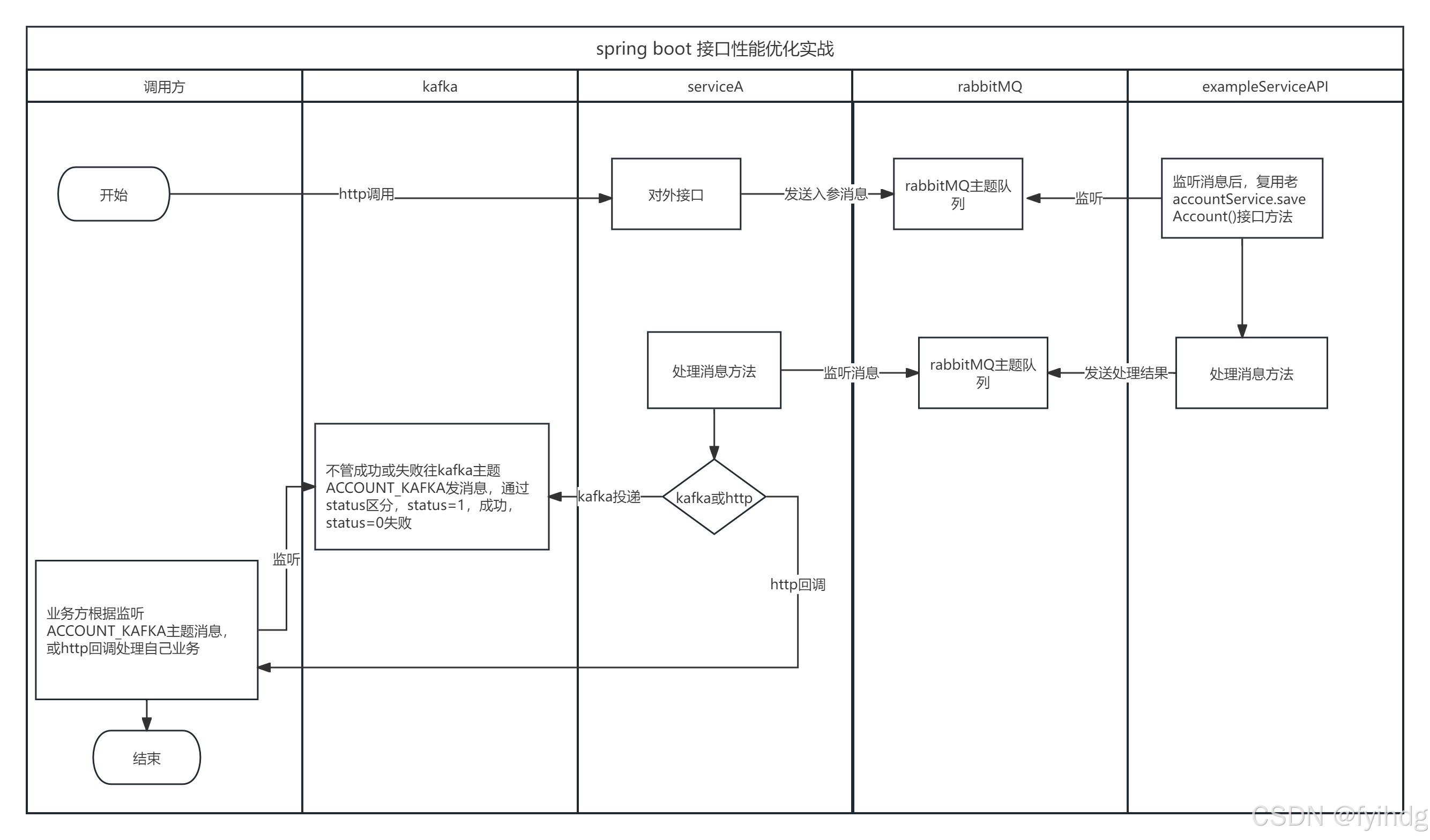
设计说明:
再搭建一个新微服务:exampleServiceAPI,接入kafka和rabbitMq,由exampleServiceAPI服务对外提供接口;当业务方调用接口的时候,exampleServiceAPI服务处理请求,直接响应,然后exampleServiceAPI服务用把此次请求入参通过rabbbitMq给serviceA服务发消息serviceA收到消息后,复用原来accountService.saveAccount()接口方法处理业务逻辑,把处理结果又通过rabbitMq发exampleServiceAPI这个新服务;exampleServiceAPI收到rabbitMq消息进行处理,不管成功或失败,把消费结果发送到kafka主题:ACCOUNT_KAFKA,成功或失败,通过status区分status=1,成功,status=0失败,调用方根据这个主题消费消息处理自己的业务逻辑。接下来搭项目演示优化过程。
2.搭建serviceA服务
2.1接入 RabbitMQ
java
package com.performance.optimization.config;
import lombok.extern.slf4j.Slf4j;
import org.springframework.amqp.core.*;
import org.springframework.amqp.rabbit.config.SimpleRabbitListenerContainerFactory;
import org.springframework.amqp.rabbit.connection.CachingConnectionFactory;
import org.springframework.amqp.rabbit.connection.ConnectionFactory;
import org.springframework.amqp.rabbit.core.RabbitTemplate;
import org.springframework.amqp.support.converter.MessageConversionException;
import org.springframework.amqp.support.converter.MessageConverter;
import org.springframework.beans.factory.annotation.Qualifier;
import org.springframework.beans.factory.annotation.Value;
import org.springframework.boot.autoconfigure.amqp.SimpleRabbitListenerContainerFactoryConfigurer;
import org.springframework.context.annotation.Bean;
import org.springframework.context.annotation.Configuration;
import java.util.HashMap;
import java.util.Map;
import java.util.UUID;
import static com.performance.optimization.constant.MQConstants.*;
@Slf4j
@Configuration
public class RabbitMQConfig {
/* *
*创建连接工厂
*/
@Bean(name = "accountMsgConnectionFactory")
public ConnectionFactory accountMsgConnectionFactory(@Value("${hdg.rabbitmq.my-rabbit.address}") String address,
@Value("${hdg.rabbitmq.my-rabbit.username}") String username,
@Value("${hdg.rabbitmq.my-rabbit.password}") String password,
@Value("${hdg.rabbitmq.my-rabbit.virtual-host}") String vHost) {
CachingConnectionFactory connectionFactory = new CachingConnectionFactory();
connectionFactory.setAddresses(address);
connectionFactory.setUsername(username);
connectionFactory.setPassword(password);
connectionFactory.setVirtualHost(vHost);
//设置发送方确认
connectionFactory.setPublisherConfirmType(CachingConnectionFactory.ConfirmType.CORRELATED);
return connectionFactory;
}
/**
* 生产者
*/
@Bean(name = "accountMsgRabbitTemplate")
public RabbitTemplate accountMsgRabbitTemplate(@Qualifier("accountMsgConnectionFactory") ConnectionFactory connectionFactory) {
RabbitTemplate template = new RabbitTemplate();
template.setConnectionFactory(connectionFactory);
//设置messageId
template.setMessageConverter(new MessageConverter() {
@Override
public Message toMessage(Object o, MessageProperties messageProperties) throws MessageConversionException {
//设置UUID作为消息唯一标识
String uuid = UUID.randomUUID().toString();
messageProperties.setMessageId(uuid);
return new Message(o.toString().getBytes(),messageProperties);
}
@Override
public Object fromMessage(Message message) throws MessageConversionException {
return message;
}
});
template.setConfirmCallback((correlationData, ack, cause) -> {
if (!ack) {
log.error("[confirm][发送消息到exchange失败 correlationData: {} cause: {}]", correlationData, cause);
}
}
);
return template;
}
@Bean("accountQueue")
public Queue accountQueue() {
Map<String, Object> args = new HashMap<>(2);
args.put("x-dead-letter-exchange", DEAD_LETTER_EXCHANGE);
args.put("x-dead-letter-routing-key", DEAD_LETTER_ACCOUNT_QUEUE_ROUTING_KEY);
return QueueBuilder.durable(ACCOUNT_RESULT_QUEUE).withArguments(args).build();
}
@Bean("accountResultExchange")
public DirectExchange accountExchange() {
return new DirectExchange(ACCOUNT_RESULT_EXCHANGE);
}
@Bean
public Binding bindingaccount(@Qualifier("accountQueue") Queue queue, @Qualifier("accountResultExchange") DirectExchange directExchange) {
return BindingBuilder.bind(queue).to(directExchange).with(ACCOUNT_QUEUE_ROUTING_RESULT_KEY);
}
@Bean(name = "accountMsgListenerFactory")
public SimpleRabbitListenerContainerFactory firstListenerFactory(
SimpleRabbitListenerContainerFactoryConfigurer configurer,
@Qualifier("accountMsgConnectionFactory") ConnectionFactory connectionFactory) {
SimpleRabbitListenerContainerFactory listenerContainerFactory = new SimpleRabbitListenerContainerFactory();
//设置手动ack
listenerContainerFactory.setAcknowledgeMode(AcknowledgeMode.MANUAL);
configurer.configure(listenerContainerFactory, connectionFactory);
return listenerContainerFactory;
}
}2.2 接入redis
java
package com.performance.optimization.config;
import com.fasterxml.jackson.annotation.PropertyAccessor;
import com.fasterxml.jackson.annotation.JsonAutoDetect.Visibility;
import com.fasterxml.jackson.annotation.JsonTypeInfo.As;
import com.fasterxml.jackson.databind.ObjectMapper;
import com.fasterxml.jackson.databind.ObjectMapper.DefaultTyping;
import com.fasterxml.jackson.databind.jsontype.impl.LaissezFaireSubTypeValidator;
import com.performance.optimization.utils.RedisUtil;
import io.lettuce.core.cluster.ClusterClientOptions;
import io.lettuce.core.cluster.ClusterTopologyRefreshOptions;
import java.util.HashSet;
import java.util.Set;
import org.apache.commons.pool2.impl.GenericObjectPoolConfig;
import org.springframework.beans.factory.annotation.Autowired;
import org.springframework.boot.autoconfigure.condition.ConditionalOnProperty;
import org.springframework.boot.autoconfigure.data.redis.RedisProperties;
import org.springframework.boot.context.properties.EnableConfigurationProperties;
import org.springframework.context.annotation.Bean;
import org.springframework.context.annotation.Configuration;
import org.springframework.data.redis.connection.RedisClusterConfiguration;
import org.springframework.data.redis.connection.RedisConnectionFactory;
import org.springframework.data.redis.connection.RedisSentinelConfiguration;
import org.springframework.data.redis.connection.RedisStandaloneConfiguration;
import org.springframework.data.redis.connection.lettuce.LettuceClientConfiguration;
import org.springframework.data.redis.connection.lettuce.LettuceConnectionFactory;
import org.springframework.data.redis.connection.lettuce.LettucePoolingClientConfiguration;
import org.springframework.data.redis.core.RedisTemplate;
import org.springframework.data.redis.serializer.Jackson2JsonRedisSerializer;
import org.springframework.data.redis.serializer.StringRedisSerializer;
@Configuration
@EnableConfigurationProperties({RedisProperties.class})
public class RedisAutoConfig {
@Autowired
private RedisProperties redisProperties;
public RedisAutoConfig() {
}
public GenericObjectPoolConfig genericObjectPoolConfig() {
GenericObjectPoolConfig config = new GenericObjectPoolConfig();
config.setMinIdle(this.redisProperties.getLettuce().getPool().getMinIdle());
config.setMinIdle(this.redisProperties.getLettuce().getPool().getMaxIdle());
config.setMaxTotal(this.redisProperties.getLettuce().getPool().getMaxActive());
return config;
}
public LettuceClientConfiguration clusterClientConfiguration() {
ClusterTopologyRefreshOptions clusterTopologyRefreshOptions = ClusterTopologyRefreshOptions.builder().enableAllAdaptiveRefreshTriggers().enablePeriodicRefresh().build();
ClusterClientOptions clusterClientOptions = ClusterClientOptions.builder().topologyRefreshOptions(clusterTopologyRefreshOptions).build();
LettuceClientConfiguration lettuceClientConfiguration = LettucePoolingClientConfiguration.builder().poolConfig(this.genericObjectPoolConfig()).clientOptions(clusterClientOptions).build();
return lettuceClientConfiguration;
}
public RedisClusterConfiguration clusterConfiguration() {
RedisClusterConfiguration clusterConfiguration = new RedisClusterConfiguration(this.redisProperties.getCluster().getNodes());
clusterConfiguration.setMaxRedirects(this.redisProperties.getCluster().getMaxRedirects());
clusterConfiguration.setUsername(this.redisProperties.getUsername());
clusterConfiguration.setPassword(this.redisProperties.getPassword());
return clusterConfiguration;
}
public LettuceConnectionFactory clusterConnectionFactory() {
LettuceConnectionFactory lettuceConnectionFactory = new LettuceConnectionFactory(this.clusterConfiguration(), this.clusterClientConfiguration());
lettuceConnectionFactory.afterPropertiesSet();
return lettuceConnectionFactory;
}
public LettuceClientConfiguration sentinelClientConfiguration() {
LettucePoolingClientConfiguration.LettucePoolingClientConfigurationBuilder builder = LettucePoolingClientConfiguration.builder();
builder.poolConfig(this.genericObjectPoolConfig());
ClusterClientOptions clusterClientOptions = ClusterClientOptions.builder().build();
builder.clientOptions(clusterClientOptions);
LettuceClientConfiguration lettuceClientConfiguration = builder.build();
return lettuceClientConfiguration;
}
public RedisSentinelConfiguration redisSentinelConfiguration() {
Set<String> nodes = new HashSet(this.redisProperties.getSentinel().getNodes());
RedisSentinelConfiguration sentinelConfig = new RedisSentinelConfiguration(this.redisProperties.getSentinel().getMaster(), nodes);
sentinelConfig.setSentinelPassword(this.redisProperties.getSentinel().getPassword());
sentinelConfig.setUsername(this.redisProperties.getUsername());
sentinelConfig.setPassword(this.redisProperties.getPassword());
sentinelConfig.setDatabase(this.redisProperties.getDatabase());
return sentinelConfig;
}
public LettuceConnectionFactory sentinelConnectionFactory() {
LettuceConnectionFactory factory = new LettuceConnectionFactory(this.redisSentinelConfiguration(), this.sentinelClientConfiguration());
factory.afterPropertiesSet();
return factory;
}
public RedisStandaloneConfiguration redisStandaloneConfiguration() {
RedisStandaloneConfiguration standaloneConfiguration = new RedisStandaloneConfiguration(this.redisProperties.getHost(), this.redisProperties.getPort());
standaloneConfiguration.setUsername(this.redisProperties.getUsername());
standaloneConfiguration.setPassword(this.redisProperties.getPassword());
if (this.redisProperties.getDatabase() >= 0) {
standaloneConfiguration.setDatabase(this.redisProperties.getDatabase());
}
return standaloneConfiguration;
}
public LettuceConnectionFactory standaloneConnectionFactory() {
LettuceConnectionFactory factory = new LettuceConnectionFactory(this.redisStandaloneConfiguration(), this.sentinelClientConfiguration());
factory.afterPropertiesSet();
return factory;
}
protected RedisTemplate<String, Object> getRedisTemplate(RedisConnectionFactory factory) {
RedisTemplate<String, Object> template = new RedisTemplate();
template.setConnectionFactory(factory);
Jackson2JsonRedisSerializer<Object> jackson2JsonRedisSerializer = new Jackson2JsonRedisSerializer(Object.class);
ObjectMapper om = new ObjectMapper();
om.setVisibility(PropertyAccessor.ALL, Visibility.ANY);
om.activateDefaultTyping(LaissezFaireSubTypeValidator.instance, DefaultTyping.NON_FINAL, As.PROPERTY);
jackson2JsonRedisSerializer.setObjectMapper(om);
StringRedisSerializer stringRedisSerializer = new StringRedisSerializer();
template.setKeySerializer(stringRedisSerializer);
template.setValueSerializer(jackson2JsonRedisSerializer);
template.setHashKeySerializer(stringRedisSerializer);
template.setHashValueSerializer(jackson2JsonRedisSerializer);
template.afterPropertiesSet();
return template;
}
@Bean(
name = {"clusterRedisUtil"}
)
@ConditionalOnProperty(
prefix = "spring.redis.cluster",
name = {"active"},
havingValue = "true"
)
public RedisUtil redisUtil() {
return new RedisUtil(this.getRedisTemplate(this.clusterConnectionFactory()));
}
@Bean(
name = {"sentinelRedisUtil"}
)
@ConditionalOnProperty(
prefix = "spring.redis.sentinel",
name = {"master"}
)
public RedisUtil sentinelRedisUtil() {
return new RedisUtil(this.getRedisTemplate(this.sentinelConnectionFactory()));
}
@Bean(
name = {"standaloneRedisUtil"}
)
@ConditionalOnProperty(
prefix = "spring.redis",
name = {"host"}
)
public RedisUtil standaloneRedisUtil() {
return new RedisUtil(this.getRedisTemplate(this.standaloneConnectionFactory()));
}
}
java
package com.performance.optimization.constant;
public class MQConstants {
public static final String DEAD_LETTER_EXCHANGE = "DEAD_LETTER_EXCHANGE";
public static final String DEAD_LETTER_ACCOUNT_QUEUE_ROUTING_KEY = "DEAD_LETTER_ACCOUNT_QUEUE_ROUTING_KEY";
public static final String ACCOUNT_RESULT_EXCHANGE = "ACCOUNT_RESULT_EXCHANGE";
public static final String ACCOUNT_QUEUE_ROUTING_RESULT_KEY = "ACCOUNT_QUEUE_ROUTING_RESULT_KEY";
public static final String ACCOUNT_RESULT_QUEUE = "ACCOUNT_RESULT_QUEUE";
}2.3 监听exampleServiceAPI过来的数据
这里我要讲一下@RabbitListener这个注解中的queuesToDeclare属性,如果没有队列,服务启动后会自动创建队列,就算你手动删除,也会立即自动创建,不用手动创建队列。程序创建队列有两个场景,一个是@RabbitListener这个注解,服务启动的时候,如果没有队列,这个注解会自动创建队列,如果已有队列,则不会创建;另一个是QueueBuilder.durable()方法也会自动创建列队,如果队列已存在,也不会创建。
现在会有一个问题要注意:serviceA服务监听accountQueue队列和exampleServiceAPI服务有QueueBuilder.durable("accountQueue").withArguments(args).build()代码创建队列,两边创建时队属性要完全一样,否则服务启动时就会报错了。
也就是说假如serviceA服务是这样写的:
java
@Bean("accountQueue")
public Queue accountQueue() {
Map<String, Object> args = new HashMap<>(2);
return QueueBuilder.durable(ACCOUNT_RESULT_QUEUE).withArguments(args).build();
}exampleServiceAPI这样写:
java
@Bean("accountQueue")
public Queue accountQueue() {
Map<String, Object> args = new HashMap<>(2);
args.put("x-dead-letter-exchange", DEAD_LETTER_EXCHANGE);
args.put("x-dead-letter-routing-key", DEAD_LETTER_ACCOUNT_QUEUE_ROUTING_KEY);
return QueueBuilder.durable("accountQueue").withArguments(args).build();
}serviceA服务启动后,发现没有accountQueue这个队列,会自动创建,然后到exampleServiceAPI启动了,发现有这个队列,但属性不一样,就会报错了
java
channel error; protocol method: #method<channel.close>(reply-code=406, reply-text=PRECONDITION_FAILED - inequivalent arg 'x-dead-letter-exchange' for queue 'accountQueue' in vhost '/': received the value 'DEAD_LETTER_EXCHANGE' of type 'longstr' but current is none, class-id=50, method-id=10)
java
package com.performance.optimization.consumer;
import com.alibaba.nacos.shaded.com.google.gson.Gson;
import com.performance.optimization.dto.AccountDto;
import com.performance.optimization.dto.AccountResponseDto;
import com.performance.optimization.producer.AccountTaskProducer;
import com.performance.optimization.service.AccountService;
import com.performance.optimization.service.DBService;
import com.performance.optimization.utils.RedisUtil;
import com.rabbitmq.client.Channel;
import lombok.extern.slf4j.Slf4j;
import org.springframework.amqp.core.Message;
import org.springframework.amqp.rabbit.annotation.Argument;
import org.springframework.amqp.rabbit.annotation.Queue;
import org.springframework.amqp.rabbit.annotation.RabbitListener;
import org.springframework.beans.factory.annotation.Autowired;
import org.springframework.stereotype.Component;
import javax.annotation.Resource;
import java.io.IOException;
import java.nio.charset.StandardCharsets;
import static com.performance.optimization.constant.MQConstants.DEAD_LETTER_ACCOUNT_QUEUE_ROUTING_KEY;
import static com.performance.optimization.constant.MQConstants.DEAD_LETTER_EXCHANGE;
@Component
@Slf4j
public class AccountTaskConsumer {
@Resource
private RedisUtil redisUtil;
/**
* 模拟数据库由于高并发连接不够
*/
@Autowired
private DBService dbService;
@Autowired
private AccountService accountService;
@Autowired
AccountTaskProducer accountTaskProducer;
/**
* 监听exampleServiceAPI过来的数据
* @param message
* @param channel
* @throws IOException
*/
@RabbitListener(queuesToDeclare =@Queue(value ="accountQueue",arguments = {
@Argument(name = "x-dead-letter-exchange", value = DEAD_LETTER_EXCHANGE),
@Argument(name = "x-dead-letter-routing-key", value = DEAD_LETTER_ACCOUNT_QUEUE_ROUTING_KEY)
}) ,containerFactory = "accountMsgListenerFactory")
public void handleAccountTaskCreateOrUpdate(Channel channel, Message message) throws IOException {
log.info("-------------------account消费开始-----------------------------");
boolean ack = true;
Exception exception = null;
Gson gson = new Gson();
try {
//获得消息内容
String accountDtoParam = new String(message.getBody(), StandardCharsets.UTF_8);
log.info("MQ消息中accountDtoParam:{}", accountDtoParam);
AccountDto accountDto = gson.fromJson(accountDtoParam, AccountDto.class);
boolean flag = accountService.saveAccount(accountDto);
String accountData = dbService.useDb("select * from account");
log.info("consumeraccountData:{}",accountData);
if(flag){
AccountResponseDto accountResponseDto = new AccountResponseDto();
accountResponseDto.setCode(0);
accountResponseDto.setMessage("成功");
//把处理结果发送出去,发到exampleServiceAPI
accountTaskProducer.workbenchResultSend(gson.toJson(accountResponseDto));
}else{
AccountResponseDto accountResponseDto = new AccountResponseDto();
accountResponseDto.setCode(1);
accountResponseDto.setMessage("失败");
//把处理结果发送出去,发到exampleServiceAPI
accountTaskProducer.workbenchResultSend(gson.toJson(accountResponseDto));
}
} catch (Exception e) {
ack = false;
exception = e;
AccountResponseDto accountResponseDto = new AccountResponseDto();
accountResponseDto.setCode(2);
accountResponseDto.setMessage("失败");
//把处理结果发送出去,发到exampleServiceAPI
accountTaskProducer.workbenchResultSend(gson.toJson(accountResponseDto));
}
checkAck(ack, message, channel, exception);
log.info("---------------------account消费结束-----------------------------");
}
public void checkAck(Boolean ack, Message message, Channel channel, Exception exception) throws IOException {
String msgId = "";
if (!ack) {
log.error("消费消息发生异常, error msg:{}", exception.getMessage(), exception);
msgId = message.getMessageProperties().getMessageId();
Integer retryCount = 0;
if (msgId != null && redisUtil.exists(msgId)) {
retryCount = (Integer) redisUtil.get(msgId);
//messageId为空,直接放到死信队列
} else {
retryCount = 2;
}
//小于最大重试次数,重新消费
if (retryCount < 2) {
channel.basicNack(message.getMessageProperties().getDeliveryTag(), false, true);
redisUtil.set(msgId, retryCount + 1);
} else { //大于最大重试次数,放到死信队列
channel.basicNack(message.getMessageProperties().getDeliveryTag(), false, false);
}
} else { //确认消费成功
channel.basicAck(message.getMessageProperties().getDeliveryTag(), false);
redisUtil.del(msgId);
}
}
}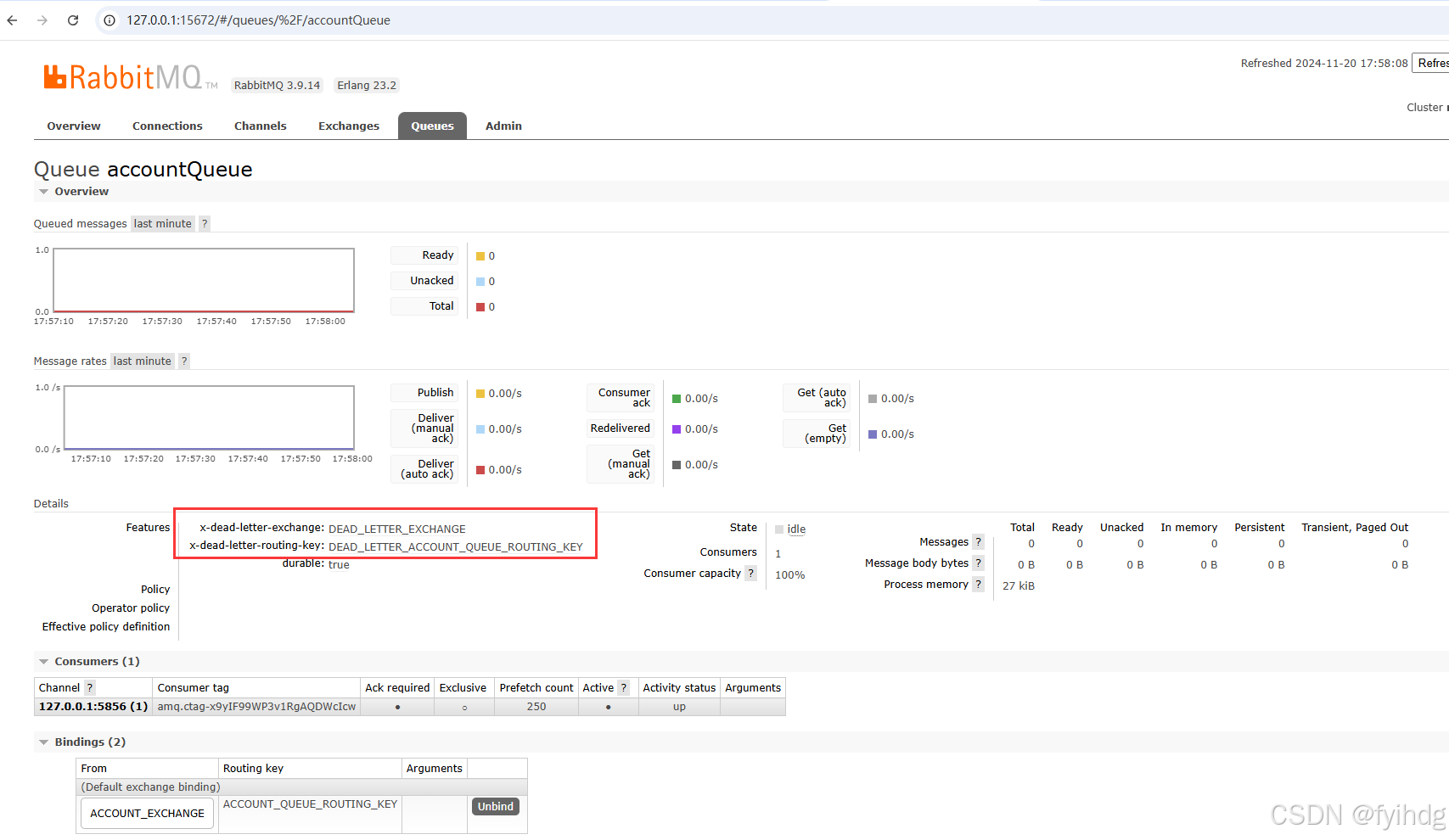
2.4数据库连接改造
由于要模拟高并发下数据库连接不够,我们使用我们自己写的连接,把连接数量减少,就可以模拟出线上环境数据库连接不够的问题。
java
package com.performance.optimization.db;
import org.springframework.stereotype.Component;
import java.sql.Connection;
import java.util.LinkedList;
/**
* 类说明:数据库连接池简单实现,线程安全,限定了连接池为2个大小
*/
@Component
public class DBPool {
//数据库池的容器
private static LinkedList<Connection> pool = new LinkedList<>();
//线程安全,限定了连接池为2个大小
private final static int CONNECT_CONUT = 2;
static{
for(int i=0;i<CONNECT_CONUT;i++) {
pool.addLast(SqlConnectImpl.fetchConnection());
}
}
//在mills时间内还拿不到数据库连接,返回一个null
public Connection fetchConn(long mills) throws InterruptedException {
synchronized (pool) {
if (mills<0) {
while(pool.isEmpty()) {
pool.wait();
}
return pool.removeFirst();
}else {
long overtime = System.currentTimeMillis()+mills;
long remain = mills;
while(pool.isEmpty()&&remain>0) {
pool.wait(remain);
remain = overtime - System.currentTimeMillis();
}
Connection result = null;
if(!pool.isEmpty()) {
result = pool.removeFirst();
}
return result;
}
}
}
//放回数据库连接
public void releaseConn(Connection conn) {
if(conn!=null) {
synchronized (pool) {
pool.addLast(conn);
pool.notifyAll();
}
}
}
}
java
package com.performance.optimization.db;
import java.util.concurrent.TimeUnit;
/**
* 类说明:模拟数据库服务
*/
public class SleepTools {
/**
* 按秒休眠
* @param seconds 秒数
*/
public static final void second(int seconds) {
try {
TimeUnit.SECONDS.sleep(seconds);
} catch (InterruptedException e) {
}
}
/**
* 按毫秒数休眠
* @param seconds 毫秒数
*/
public static final void ms(int seconds) {
try {
TimeUnit.MILLISECONDS.sleep(seconds);
} catch (InterruptedException e) {
}
}
}
java
package com.performance.optimization.db;
import java.sql.*;
import java.util.Map;
import java.util.Properties;
import java.util.concurrent.Executor;
/**
* 类说明:数据库连接的实现
*/
public class SqlConnectImpl implements Connection{
/*拿一个数据库连接*/
public static final Connection fetchConnection(){
return new SqlConnectImpl();
}
@Override
public void commit() throws SQLException {
SleepTools.ms(70);
}
// 其他未实现,省略,直接用idea 工具生成就行
}2.5 生产者
java
package com.performance.optimization.producer;
import lombok.extern.slf4j.Slf4j;
import org.springframework.amqp.rabbit.core.RabbitTemplate;
import org.springframework.stereotype.Component;
import javax.annotation.Resource;
import static com.performance.optimization.constant.MQConstants.ACCOUNT_RESULT_QUEUE;
/**
* 生产者
*/
@Component
@Slf4j
public class AccountTaskProducer {
@Resource
private RabbitTemplate rabbitTemplate;
/**
* 把消费结果发送回exampleServiceAPI
*/
public void workbenchResultSend(String accountDtoParam) {
log.info("serviceA处理后返回1={}" ,accountDtoParam);
rabbitTemplate.convertAndSend(ACCOUNT_RESULT_QUEUE, accountDtoParam);
}
/**
* 把消费结果发送回 exampleServiceAPI
*/
public void workbenchResultSend(boolean flag) {
log.info("serviceA处理后返回2={}" ,flag);
rabbitTemplate.convertAndSend(ACCOUNT_RESULT_QUEUE, flag);
}
}2.6 配置 application.yml 的pom.xml
java
server:
port: 8082
spring:
application:
name: serviceA
cloud:
nacos:
config:
server-addr: ${NACOS_SERVER:127.0.0.1:8848}
#服务发现
discovery:
server-addr: ${NACOS_SERVER:127.0.0.1:8848}
username: nacos
password: nacos
redis:
host: localhost
port: 6379
password:
database: 0
timeout: 5000ms
lettuce:
pool:
max-active: 8
max-wait: 1000ms
max-idle: 8
min-idle: 0
datasource:
url: jdbc:mysql://localhost:3306/hdg?useUnicode=true&characterEncoding=utf8&serverTimezone=UTC
username: root
password: root
driver-class-name: com.mysql.cj.jdbc.Driver
hikari:
maximum-pool-size: 1
minimum-idle: 1
mybatis-plus:
configuration:
log-impl: org.apache.ibatis.logging.stdout.StdOutImpl
mapper-locations: classpath:mapper/*.xml
type-aliases-package: com.performance.optimization.domain
#mq连接配置
hdg.rabbitmq:
my-rabbit:
address: 127.0.0.1:5672
username: guest
password: guest
virtual-host: /
XML
<?xml version="1.0" encoding="UTF-8"?>
<project xmlns="http://maven.apache.org/POM/4.0.0" xmlns:xsi="http://www.w3.org/2001/XMLSchema-instance"
xsi:schemaLocation="http://maven.apache.org/POM/4.0.0 https://maven.apache.org/xsd/maven-4.0.0.xsd">
<modelVersion>4.0.0</modelVersion>
<parent>
<groupId>org.springframework.boot</groupId>
<artifactId>spring-boot-starter-parent</artifactId>
<version>2.7.14</version>
<relativePath/>
</parent>
<groupId>com.performance.optimization</groupId>
<artifactId>serviceA</artifactId>
<version>0.0.1-SNAPSHOT</version>
<name>serviceA</name>
<description>serviceA</description>
<properties>
<java.version>1.8</java.version>
<spring.cloud.version>2021.0.5</spring.cloud.version>
<spring.cloud.alibaba.version>2021.0.5.0</spring.cloud.alibaba.version>
<spring.boot.version>2.7.14</spring.boot.version>
</properties>
<dependencies>
<dependency>
<groupId>org.springframework.boot</groupId>
<artifactId>spring-boot-starter-web</artifactId>
</dependency>
<dependency>
<groupId>com.mysql</groupId>
<artifactId>mysql-connector-j</artifactId>
<scope>runtime</scope>
</dependency>
<dependency>
<groupId>org.projectlombok</groupId>
<artifactId>lombok</artifactId>
<optional>true</optional>
</dependency>
<dependency>
<groupId>org.springframework.boot</groupId>
<artifactId>spring-boot-starter-test</artifactId>
<scope>test</scope>
</dependency>
<!--fastjson -->
<dependency>
<groupId>com.alibaba</groupId>
<artifactId>fastjson</artifactId>
<version>1.2.83</version>
</dependency>
<!--mybatis -->
<dependency>
<groupId>com.baomidou</groupId>
<artifactId>mybatis-plus-boot-starter</artifactId>
<version>3.4.3.2</version>
</dependency>
<!-- hutool-->
<dependency>
<groupId>cn.hutool</groupId>
<artifactId>hutool-all</artifactId>
<version>5.8.1</version>
</dependency>
<!--rabbitmq-->
<dependency>
<groupId>org.springframework.boot</groupId>
<artifactId>spring-boot-starter-amqp</artifactId>
</dependency>
<!-- redis相关-->
<dependency>
<groupId>org.springframework.boot</groupId>
<artifactId>spring-boot-starter-data-redis</artifactId>
</dependency>
<!-- 添加redis应用池依赖 -->
<dependency>
<groupId>org.apache.commons</groupId>
<artifactId>commons-pool2</artifactId>
<scope>provided</scope>
</dependency>
<dependency>
<groupId>org.springframework.cloud</groupId>
<artifactId>spring-cloud-starter-bootstrap</artifactId>
</dependency>
<!-- nacos注册中心依赖 -->
<dependency>
<groupId>com.alibaba.cloud</groupId>
<artifactId>spring-cloud-starter-alibaba-nacos-discovery</artifactId>
</dependency>
<!-- nacos配置中心依赖 -->
<dependency>
<groupId>com.alibaba.cloud</groupId>
<artifactId>spring-cloud-starter-alibaba-nacos-config</artifactId>
</dependency>
<!-- 日志 -->
<dependency>
<groupId>ch.qos.logback</groupId>
<artifactId>logback-classic</artifactId>
</dependency>
<!--日志以json格式输出所需-->
<dependency>
<groupId>net.logstash.logback</groupId>
<artifactId>logstash-logback-encoder</artifactId>
<version>6.6</version>
</dependency>
</dependencies>
<dependencyManagement>
<dependencies>
<dependency>
<groupId>org.springframework.cloud</groupId>
<artifactId>spring-cloud-dependencies</artifactId>
<version>${spring.cloud.version}</version>
<type>pom</type>
<scope>import</scope>
</dependency>
<dependency>
<groupId>com.alibaba.cloud</groupId>
<artifactId>spring-cloud-alibaba-dependencies</artifactId>
<version>${spring.cloud.alibaba.version}</version>
<type>pom</type>
<scope>import</scope>
</dependency>
<dependency>
<groupId>org.springframework.boot</groupId>
<artifactId>spring-boot-dependencies</artifactId>
<version>${spring.boot.version}</version>
<type>pom</type>
<scope>import</scope>
</dependency>
</dependencies>
</dependencyManagement>
<build>
<plugins>
<plugin>
<groupId>org.springframework.boot</groupId>
<artifactId>spring-boot-maven-plugin</artifactId>
<configuration>
<excludes>
<exclude>
<groupId>org.projectlombok</groupId>
<artifactId>lombok</artifactId>
</exclude>
</excludes>
</configuration>
</plugin>
</plugins>
</build>
</project>至此serviceA搭建好了。
3.搭建exampleServiceAPI服务
3.1 接入kafka
java
package com.example.service.api.config;
import cn.hutool.core.collection.CollUtil;
import org.apache.kafka.clients.producer.ProducerConfig;
import org.apache.kafka.common.serialization.StringSerializer;
import org.springframework.boot.autoconfigure.kafka.KafkaProperties;
import org.springframework.context.annotation.Bean;
import org.springframework.context.annotation.Configuration;
import org.springframework.kafka.core.DefaultKafkaProducerFactory;
import org.springframework.kafka.core.KafkaTemplate;
import org.springframework.kafka.core.ProducerFactory;
import java.util.HashMap;
import java.util.Map;
@Configuration
public class KafkaProducerConfig {
@Bean
public ProducerFactory<String, String> producerFactory(KafkaProperties kafkaProperties) {
Map<String, Object> configProps = new HashMap<>();
configProps.put(ProducerConfig.BOOTSTRAP_SERVERS_CONFIG,CollUtil.getFirst(kafkaProperties.getBootstrapServers()));
configProps.put(ProducerConfig.KEY_SERIALIZER_CLASS_CONFIG, StringSerializer.class);
configProps.put(ProducerConfig.VALUE_SERIALIZER_CLASS_CONFIG, StringSerializer.class);
return new DefaultKafkaProducerFactory<>(configProps);
}
@Bean
public KafkaTemplate<String, String> kafkaTemplate(ProducerFactory<String,String> producerFactory) {
return new KafkaTemplate<>(producerFactory);
}
}3.2 接入RabbitMQ
java
package com.example.service.api.config;
import lombok.extern.slf4j.Slf4j;
import org.springframework.amqp.core.*;
import org.springframework.amqp.rabbit.config.SimpleRabbitListenerContainerFactory;
import org.springframework.amqp.rabbit.connection.CachingConnectionFactory;
import org.springframework.amqp.rabbit.connection.ConnectionFactory;
import org.springframework.amqp.rabbit.core.RabbitTemplate;
import org.springframework.amqp.support.converter.MessageConversionException;
import org.springframework.amqp.support.converter.MessageConverter;
import org.springframework.beans.factory.annotation.Qualifier;
import org.springframework.beans.factory.annotation.Value;
import org.springframework.boot.autoconfigure.amqp.SimpleRabbitListenerContainerFactoryConfigurer;
import org.springframework.context.annotation.Bean;
import org.springframework.context.annotation.Configuration;
import java.util.HashMap;
import java.util.Map;
import java.util.UUID;
import static com.example.service.api.constant.MQConstants.*;
@Slf4j
@Configuration
public class RabbitMQConfig {
/* *
*创建连接工厂
*/
@Bean(name = "accountMsgConnectionFactory")
public ConnectionFactory accountMsgConnectionFactory(@Value("${hdg.rabbitmq.my-rabbit.address}") String address,
@Value("${hdg.rabbitmq.my-rabbit.username}") String username,
@Value("${hdg.rabbitmq.my-rabbit.password}") String password,
@Value("${hdg.rabbitmq.my-rabbit.virtual-host}") String vHost) {
CachingConnectionFactory connectionFactory = new CachingConnectionFactory();
connectionFactory.setAddresses(address);
connectionFactory.setUsername(username);
connectionFactory.setPassword(password);
connectionFactory.setVirtualHost(vHost);
//设置发送方确认
connectionFactory.setPublisherConfirmType(CachingConnectionFactory.ConfirmType.CORRELATED);
return connectionFactory;
}
/**
* 生产者
*/
@Bean(name = "accountMsgRabbitTemplate")
public RabbitTemplate accountMsgRabbitTemplate(@Qualifier("accountMsgConnectionFactory") ConnectionFactory connectionFactory) {
RabbitTemplate template = new RabbitTemplate();
template.setConnectionFactory(connectionFactory);
//设置messageId
template.setMessageConverter(new MessageConverter() {
@Override
public Message toMessage(Object o, MessageProperties messageProperties) throws MessageConversionException {
//设置UUID作为消息唯一标识
String uuid = UUID.randomUUID().toString();
messageProperties.setMessageId(uuid);
return new Message(o.toString().getBytes(),messageProperties);
}
@Override
public Object fromMessage(Message message) throws MessageConversionException {
return message;
}
});
template.setConfirmCallback((correlationData, ack, cause) -> {
if (!ack) {
log.error("[confirm][发送消息到exchange失败 correlationData: {} cause: {}]", correlationData, cause);
}
}
);
return template;
}
/**
* 消费者
*/
@Bean(name = "accountMsgListenerFactory")
public SimpleRabbitListenerContainerFactory firstListenerFactory(
SimpleRabbitListenerContainerFactoryConfigurer configurer,
@Qualifier("accountMsgConnectionFactory") ConnectionFactory connectionFactory) {
SimpleRabbitListenerContainerFactory listenerContainerFactory = new SimpleRabbitListenerContainerFactory();
//设置手动ack
listenerContainerFactory.setAcknowledgeMode(AcknowledgeMode.MANUAL);
configurer.configure(listenerContainerFactory, connectionFactory);
return listenerContainerFactory;
}
@Bean("accountExchange")
public DirectExchange accountExchange() {
return new DirectExchange(ACCOUNT_EXCHANGE);
}
@Bean
public Binding bindingOpenapi(@Qualifier("accountQueue") Queue queue, @Qualifier("accountExchange") DirectExchange directExchange) {
return BindingBuilder.bind(queue).to(directExchange).with(ACCOUNT_QUEUE_ROUTING_KEY);
}
@Bean("accountQueue")
public Queue accountQueue() {
Map<String, Object> args = new HashMap<>(2);
args.put("x-dead-letter-exchange", DEAD_LETTER_EXCHANGE);
args.put("x-dead-letter-routing-key", DEAD_LETTER_ACCOUNT_QUEUE_ROUTING_KEY);
return QueueBuilder.durable("accountQueue").withArguments(args).build();
}
}
java
package com.example.service.api.constant;
public class MQConstants {
public static final String DEAD_LETTER_EXCHANGE = "DEAD_LETTER_EXCHANGE";
public static final String DEAD_LETTER_ACCOUNT_QUEUE_ROUTING_KEY = "DEAD_LETTER_ACCOUNT_QUEUE_ROUTING_KEY";
public static final String ACCOUNT_EXCHANGE = "ACCOUNT_EXCHANGE";
public static final String ACCOUNT_QUEUE_ROUTING_KEY = "ACCOUNT_QUEUE_ROUTING_KEY";
public static final String ACCOUNT_RESULT_QUEUE = "ACCOUNT_RESULT_QUEUE";
}3.3 接入redis
java
package com.example.service.api.config;
import com.example.service.api.utils.RedisUtil;
import com.fasterxml.jackson.annotation.JsonAutoDetect.Visibility;
import com.fasterxml.jackson.annotation.JsonTypeInfo.As;
import com.fasterxml.jackson.annotation.PropertyAccessor;
import com.fasterxml.jackson.databind.ObjectMapper;
import com.fasterxml.jackson.databind.ObjectMapper.DefaultTyping;
import com.fasterxml.jackson.databind.jsontype.impl.LaissezFaireSubTypeValidator;
import io.lettuce.core.cluster.ClusterClientOptions;
import io.lettuce.core.cluster.ClusterTopologyRefreshOptions;
import org.apache.commons.pool2.impl.GenericObjectPoolConfig;
import org.springframework.beans.factory.annotation.Autowired;
import org.springframework.boot.autoconfigure.condition.ConditionalOnProperty;
import org.springframework.boot.autoconfigure.data.redis.RedisProperties;
import org.springframework.boot.context.properties.EnableConfigurationProperties;
import org.springframework.context.annotation.Bean;
import org.springframework.context.annotation.Configuration;
import org.springframework.data.redis.connection.RedisClusterConfiguration;
import org.springframework.data.redis.connection.RedisConnectionFactory;
import org.springframework.data.redis.connection.RedisSentinelConfiguration;
import org.springframework.data.redis.connection.RedisStandaloneConfiguration;
import org.springframework.data.redis.connection.lettuce.LettuceClientConfiguration;
import org.springframework.data.redis.connection.lettuce.LettuceConnectionFactory;
import org.springframework.data.redis.connection.lettuce.LettucePoolingClientConfiguration;
import org.springframework.data.redis.core.RedisTemplate;
import org.springframework.data.redis.serializer.Jackson2JsonRedisSerializer;
import org.springframework.data.redis.serializer.StringRedisSerializer;
import java.util.HashSet;
import java.util.Set;
@Configuration
@EnableConfigurationProperties({RedisProperties.class})
public class RedisAutoConfig {
@Autowired
private RedisProperties redisProperties;
public RedisAutoConfig() {
}
public GenericObjectPoolConfig genericObjectPoolConfig() {
GenericObjectPoolConfig config = new GenericObjectPoolConfig();
config.setMinIdle(this.redisProperties.getLettuce().getPool().getMinIdle());
config.setMinIdle(this.redisProperties.getLettuce().getPool().getMaxIdle());
config.setMaxTotal(this.redisProperties.getLettuce().getPool().getMaxActive());
return config;
}
public LettuceClientConfiguration clusterClientConfiguration() {
ClusterTopologyRefreshOptions clusterTopologyRefreshOptions = ClusterTopologyRefreshOptions.builder().enableAllAdaptiveRefreshTriggers().enablePeriodicRefresh().build();
ClusterClientOptions clusterClientOptions = ClusterClientOptions.builder().topologyRefreshOptions(clusterTopologyRefreshOptions).build();
LettuceClientConfiguration lettuceClientConfiguration = LettucePoolingClientConfiguration.builder().poolConfig(this.genericObjectPoolConfig()).clientOptions(clusterClientOptions).build();
return lettuceClientConfiguration;
}
public RedisClusterConfiguration clusterConfiguration() {
RedisClusterConfiguration clusterConfiguration = new RedisClusterConfiguration(this.redisProperties.getCluster().getNodes());
clusterConfiguration.setMaxRedirects(this.redisProperties.getCluster().getMaxRedirects());
clusterConfiguration.setUsername(this.redisProperties.getUsername());
clusterConfiguration.setPassword(this.redisProperties.getPassword());
return clusterConfiguration;
}
public LettuceConnectionFactory clusterConnectionFactory() {
LettuceConnectionFactory lettuceConnectionFactory = new LettuceConnectionFactory(this.clusterConfiguration(), this.clusterClientConfiguration());
lettuceConnectionFactory.afterPropertiesSet();
return lettuceConnectionFactory;
}
public LettuceClientConfiguration sentinelClientConfiguration() {
LettucePoolingClientConfiguration.LettucePoolingClientConfigurationBuilder builder = LettucePoolingClientConfiguration.builder();
builder.poolConfig(this.genericObjectPoolConfig());
ClusterClientOptions clusterClientOptions = ClusterClientOptions.builder().build();
builder.clientOptions(clusterClientOptions);
LettuceClientConfiguration lettuceClientConfiguration = builder.build();
return lettuceClientConfiguration;
}
public RedisSentinelConfiguration redisSentinelConfiguration() {
Set<String> nodes = new HashSet(this.redisProperties.getSentinel().getNodes());
RedisSentinelConfiguration sentinelConfig = new RedisSentinelConfiguration(this.redisProperties.getSentinel().getMaster(), nodes);
sentinelConfig.setSentinelPassword(this.redisProperties.getSentinel().getPassword());
sentinelConfig.setUsername(this.redisProperties.getUsername());
sentinelConfig.setPassword(this.redisProperties.getPassword());
sentinelConfig.setDatabase(this.redisProperties.getDatabase());
return sentinelConfig;
}
public LettuceConnectionFactory sentinelConnectionFactory() {
LettuceConnectionFactory factory = new LettuceConnectionFactory(this.redisSentinelConfiguration(), this.sentinelClientConfiguration());
factory.afterPropertiesSet();
return factory;
}
public RedisStandaloneConfiguration redisStandaloneConfiguration() {
RedisStandaloneConfiguration standaloneConfiguration = new RedisStandaloneConfiguration(this.redisProperties.getHost(), this.redisProperties.getPort());
standaloneConfiguration.setUsername(this.redisProperties.getUsername());
standaloneConfiguration.setPassword(this.redisProperties.getPassword());
if (this.redisProperties.getDatabase() >= 0) {
standaloneConfiguration.setDatabase(this.redisProperties.getDatabase());
}
return standaloneConfiguration;
}
public LettuceConnectionFactory standaloneConnectionFactory() {
LettuceConnectionFactory factory = new LettuceConnectionFactory(this.redisStandaloneConfiguration(), this.sentinelClientConfiguration());
factory.afterPropertiesSet();
return factory;
}
protected RedisTemplate<String, Object> getRedisTemplate(RedisConnectionFactory factory) {
RedisTemplate<String, Object> template = new RedisTemplate();
template.setConnectionFactory(factory);
Jackson2JsonRedisSerializer<Object> jackson2JsonRedisSerializer = new Jackson2JsonRedisSerializer(Object.class);
ObjectMapper om = new ObjectMapper();
om.setVisibility(PropertyAccessor.ALL, Visibility.ANY);
om.activateDefaultTyping(LaissezFaireSubTypeValidator.instance, DefaultTyping.NON_FINAL, As.PROPERTY);
jackson2JsonRedisSerializer.setObjectMapper(om);
StringRedisSerializer stringRedisSerializer = new StringRedisSerializer();
template.setKeySerializer(stringRedisSerializer);
template.setValueSerializer(jackson2JsonRedisSerializer);
template.setHashKeySerializer(stringRedisSerializer);
template.setHashValueSerializer(jackson2JsonRedisSerializer);
template.afterPropertiesSet();
return template;
}
@Bean(
name = {"clusterRedisUtil"}
)
@ConditionalOnProperty(
prefix = "spring.redis.cluster",
name = {"active"},
havingValue = "true"
)
public RedisUtil redisUtil() {
return new RedisUtil(this.getRedisTemplate(this.clusterConnectionFactory()));
}
@Bean(
name = {"sentinelRedisUtil"}
)
@ConditionalOnProperty(
prefix = "spring.redis.sentinel",
name = {"master"}
)
public RedisUtil sentinelRedisUtil() {
return new RedisUtil(this.getRedisTemplate(this.sentinelConnectionFactory()));
}
@Bean(
name = {"standaloneRedisUtil"}
)
@ConditionalOnProperty(
prefix = "spring.redis",
name = {"host"}
)
public RedisUtil standaloneRedisUtil() {
return new RedisUtil(this.getRedisTemplate(this.standaloneConnectionFactory()));
}
}3.4 监听serviceA发过来的消息
java
package com.example.service.api.consumer;
import com.example.service.api.producer.Producer;
import com.example.service.api.utils.RedisUtil;
import com.rabbitmq.client.Channel;
import lombok.extern.slf4j.Slf4j;
import org.springframework.amqp.core.Message;
import org.springframework.amqp.rabbit.annotation.Argument;
import org.springframework.amqp.rabbit.annotation.Queue;
import org.springframework.amqp.rabbit.annotation.RabbitListener;
import org.springframework.beans.factory.annotation.Autowired;
import org.springframework.data.redis.core.RedisTemplate;
import org.springframework.stereotype.Component;
import javax.annotation.Resource;
import java.io.IOException;
import java.nio.charset.StandardCharsets;
import static com.example.service.api.constant.MQConstants.*;
@Component
@Slf4j
public class AccountTaskConsumer {
@Resource
private RedisUtil redisUtil;
@Resource
private Producer producer;
/**
* 监听serviceA发过来的消息,把消息然后发到kafka
*/
@RabbitListener(queuesToDeclare =@Queue(value =ACCOUNT_RESULT_QUEUE, arguments = {
@Argument(name = "x-dead-letter-exchange", value = DEAD_LETTER_EXCHANGE),
@Argument(name = "x-dead-letter-routing-key", value = DEAD_LETTER_ACCOUNT_QUEUE_ROUTING_KEY)
}) ,containerFactory = "accountMsgListenerFactory")
public void handleWorkbenchOpenapiMessage(Channel channel, Message message) throws Exception {
log.info("-------------------account消费开始-----------------------------");
boolean ack = true;
Exception exception = null;
try {
//获得消息内容
String msgStr = new String(message.getBody(), StandardCharsets.UTF_8);
log.info("接收serviceA发过来的消息:{}", msgStr);
//发到kafka
producer.sendKafkaInfo("ACCOUNT_KAFKA",msgStr);
log.info("kafka消息发送成功");
} catch (Exception e) {
ack = false;
exception = e;
}
checkAck(ack, message, channel, exception);
log.info("-------------------account消费结束-----------------------------");
}
/***
* 校验ack
* @param ack
* @param message
* @param channel
* @param exception
*/
public void checkAck(Boolean ack, Message message, Channel channel, Exception exception) throws IOException {
String msgId = "";
if (!ack) {
log.error("消费消息发生异常, error msg:{}", exception.getMessage(), exception);
msgId = message.getMessageProperties().getMessageId();
Integer retryCount = 0;
if (msgId != null && redisUtil.exists(msgId)) {
retryCount = (Integer) redisUtil.get(msgId);
//messageId为空,直接放到死信队列
} else {
retryCount = 2;
}
//小于最大重试次数,重新消费
if (retryCount < 2) {
channel.basicNack(message.getMessageProperties().getDeliveryTag(), false, true);
redisUtil.set(msgId, retryCount + 1);
} else { //大于最大重试次数,放到死信队列
channel.basicNack(message.getMessageProperties().getDeliveryTag(), false, false);
}
} else { //确认消费成功
channel.basicAck(message.getMessageProperties().getDeliveryTag(), false);
redisUtil.del(msgId);
}
}
}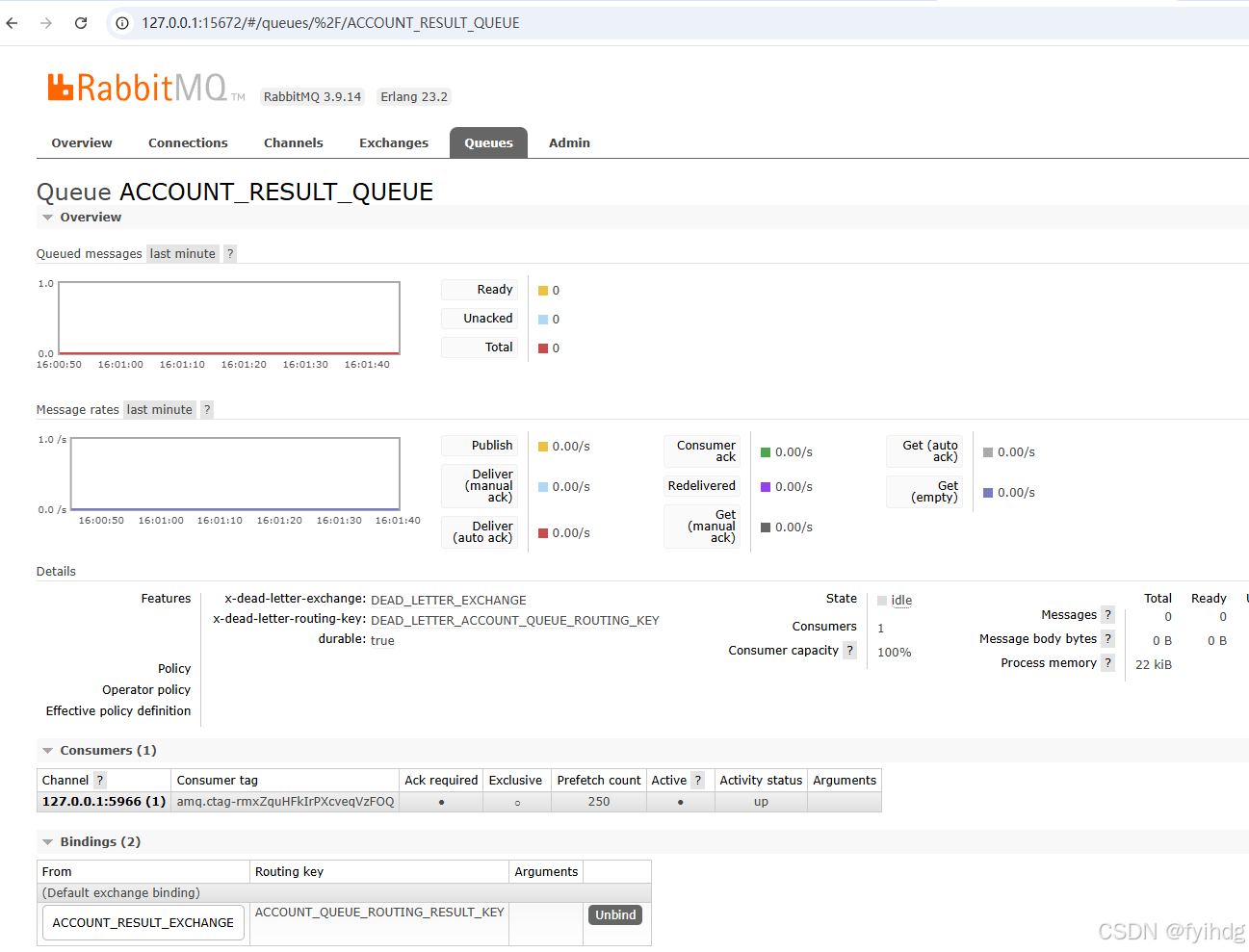
3.5 模拟业务方收到的kafka消息
调用接口返回的数据在哪里,到底有没有功能,则写在kafka消息里。
java
package com.example.service.api.consumer;
import lombok.extern.slf4j.Slf4j;
import org.springframework.kafka.annotation.KafkaListener;
import org.springframework.stereotype.Service;
@Service
@Slf4j
public class KafkaConsumerService {
/**
* 模拟业务方收到的消息,处理自己的业务逻辑
*/
@KafkaListener(topics ="ACCOUNT_KAFKA", groupId = "hdgr-group", concurrency = "4")
public void listen(String message) {
log.info("kafka收到消息:={}" , message);
}
}3.6 对外业务接口
exampleServiceAPI这个服务是专门用于对外提供接口服务的,单机部署,我们定义的接口,跟优化的接口名称,入参,都是一样,不一样的地方就是接口返回值都是true。
java
package com.example.service.api.controller;
import com.alibaba.nacos.shaded.com.google.gson.Gson;
import com.example.service.api.dto.AccountDto;
import com.example.service.api.producer.Producer;
import lombok.extern.slf4j.Slf4j;
import org.springframework.web.bind.annotation.PostMapping;
import org.springframework.web.bind.annotation.RequestBody;
import org.springframework.web.bind.annotation.RequestMapping;
import org.springframework.web.bind.annotation.RestController;
import javax.annotation.Resource;
@RestController
@RequestMapping("/serviceapi")
@Slf4j
public class ApiController {
@Resource
private Producer producer;
/**
* 模拟业务接口
* @author
*/
@PostMapping("/saveDataAcount")
public boolean saveDataAcount(@RequestBody AccountDto accountDto){
Gson gson = new Gson();
String accountDtoSt = gson.toJson(accountDto);
producer.sendRabbatimqMessage(accountDtoSt);
return true;
}
}3.7 生产者
java
package com.example.service.api.producer;
import lombok.extern.slf4j.Slf4j;
import org.springframework.amqp.rabbit.core.RabbitTemplate;
import org.springframework.kafka.core.KafkaTemplate;
import org.springframework.stereotype.Component;
import javax.annotation.Resource;
import static com.example.service.api.constant.MQConstants.ACCOUNT_EXCHANGE;
import static com.example.service.api.constant.MQConstants.ACCOUNT_QUEUE_ROUTING_KEY;
/***
* @Description 生产者
*/
@Component
@Slf4j
public class Producer {
@Resource
private RabbitTemplate rabbitTemplate;
@Resource
private KafkaTemplate<String, String> kafkaTemplate;
public void sendRabbatimqMessage(String accountDtoSt) {
log.info("外调直接入参={}" ,accountDtoSt);
rabbitTemplate.convertAndSend(ACCOUNT_EXCHANGE, ACCOUNT_QUEUE_ROUTING_KEY, accountDtoSt);
}
/**
* 发送 kafka 消息
*/
public void sendKafkaInfo(String topic,String message) {
log.info("message={}",message);
kafkaTemplate.send(topic,message);
}
}3.8 application.yml和pom.xml
java
spring:
application:
name: exampleServiceAPI
cloud:
nacos:
config:
server-addr: ${NACOS_SERVER:127.0.0.1:8848}
#服务发现
discovery:
server-addr: ${NACOS_SERVER:127.0.0.1:8848}
username: nacos
password: nacos
kafka:
bootstrap-servers: localhost:9092
producer:
key-serializer: org.apache.kafka.common.serialization.StringSerializer
value-serializer: org.apache.kafka.common.serialization.StringSerializer
retries: 1
acks: 1
batch-size: 65535
properties:
linger:
ms: 0
buffer-memory: 33554432
consumer:
key-deserializer: org.apache.kafka.common.serialization.StringDeserializer
value-deserializer: org.apache.kafka.common.serialization.StringDeserializer
enable-auto-commit: false
auto-commit-interval: 1000ms
auto-offset-reset: latest
properties:
session:
timeout:
ms: 120000
request:
timeout:
ms: 180000
max-poll-records: 50
listener:
missing-topics-fatal: false
# 手动
ack-mode: manual_immediate
#设置是否批量消费,默认 single(单条),batch(批量)
type: batch
# 自动提交 offset 默认 true
enable-auto-commit: false
# 批量消费最大数量
max-poll-records: 50
redis:
host: localhost
port: 6379
password:
database: 0
timeout: 5000ms
lettuce:
pool:
max-active: 8
max-wait: 1000ms
max-idle: 8
min-idle: 0
server:
port: 8081
#mq连接配置
hdg.rabbitmq:
my-rabbit:
address: 127.0.0.1:5672
username: guest
password: guest
virtual-host: /
logging:
level:
org.apache.kafka: ERROR
XML
<?xml version="1.0" encoding="UTF-8"?>
<project xmlns="http://maven.apache.org/POM/4.0.0" xmlns:xsi="http://www.w3.org/2001/XMLSchema-instance"
xsi:schemaLocation="http://maven.apache.org/POM/4.0.0 https://maven.apache.org/xsd/maven-4.0.0.xsd">
<modelVersion>4.0.0</modelVersion>
<parent>
<groupId>org.springframework.boot</groupId>
<artifactId>spring-boot-starter-parent</artifactId>
<version>2.7.14</version>
<relativePath/>
</parent>
<groupId>com.example.service.api</groupId>
<artifactId>exampleServiceAPI</artifactId>
<version>0.0.1-SNAPSHOT</version>
<name>exampleServiceAPI</name>
<description>exampleServiceAPI</description>
<properties>
<java.version>1.8</java.version>
<spring.cloud.version>2021.0.5</spring.cloud.version>
<spring.cloud.alibaba.version>2021.0.5.0</spring.cloud.alibaba.version>
<spring.boot.version>2.7.14</spring.boot.version>
</properties>
<dependencies>
<dependency>
<groupId>org.springframework.boot</groupId>
<artifactId>spring-boot-starter-web</artifactId>
</dependency>
<dependency>
<groupId>org.projectlombok</groupId>
<artifactId>lombok</artifactId>
<optional>true</optional>
</dependency>
<dependency>
<groupId>org.springframework.boot</groupId>
<artifactId>spring-boot-starter-test</artifactId>
<scope>test</scope>
</dependency>
<!--fastjson -->
<dependency>
<groupId>com.alibaba</groupId>
<artifactId>fastjson</artifactId>
<version>1.2.83</version>
</dependency>
<!-- hutool-->
<dependency>
<groupId>cn.hutool</groupId>
<artifactId>hutool-all</artifactId>
<version>5.8.1</version>
</dependency>
<!--rabbitmq-->
<dependency>
<groupId>org.springframework.boot</groupId>
<artifactId>spring-boot-starter-amqp</artifactId>
</dependency>
<!-- 日志 -->
<dependency>
<groupId>ch.qos.logback</groupId>
<artifactId>logback-classic</artifactId>
</dependency>
<!--日志以json格式输出所需-->
<dependency>
<groupId>net.logstash.logback</groupId>
<artifactId>logstash-logback-encoder</artifactId>
<version>6.6</version>
</dependency>
<!-- kafka -->
<dependency>
<groupId>org.springframework.kafka</groupId>
<artifactId>spring-kafka</artifactId>
</dependency>
<dependency>
<groupId>org.springframework.kafka</groupId>
<artifactId>spring-kafka-test</artifactId>
<scope>test</scope>
</dependency>
<dependency>
<groupId>org.apache.kafka</groupId>
<artifactId>kafka-clients</artifactId>
<version>3.4.0</version>
</dependency>
<!-- redis相关-->
<dependency>
<groupId>org.springframework.boot</groupId>
<artifactId>spring-boot-starter-data-redis</artifactId>
</dependency>
<!-- 添加redis应用池依赖 -->
<dependency>
<groupId>org.apache.commons</groupId>
<artifactId>commons-pool2</artifactId>
<scope>provided</scope>
</dependency>
<!--spring-cloud-->
<dependency>
<groupId>org.springframework.cloud</groupId>
<artifactId>spring-cloud-starter-bootstrap</artifactId>
</dependency>
<!-- nacos注册中心依赖 -->
<dependency>
<groupId>com.alibaba.cloud</groupId>
<artifactId>spring-cloud-starter-alibaba-nacos-discovery</artifactId>
</dependency>
<!-- nacos配置中心依赖 -->
<dependency>
<groupId>com.alibaba.cloud</groupId>
<artifactId>spring-cloud-starter-alibaba-nacos-config</artifactId>
</dependency>
</dependencies>
<dependencyManagement>
<dependencies>
<dependency>
<groupId>org.springframework.cloud</groupId>
<artifactId>spring-cloud-dependencies</artifactId>
<version>${spring.cloud.version}</version>
<type>pom</type>
<scope>import</scope>
</dependency>
<dependency>
<groupId>com.alibaba.cloud</groupId>
<artifactId>spring-cloud-alibaba-dependencies</artifactId>
<version>${spring.cloud.alibaba.version}</version>
<type>pom</type>
<scope>import</scope>
</dependency>
<dependency>
<groupId>org.springframework.boot</groupId>
<artifactId>spring-boot-dependencies</artifactId>
<version>${spring.boot.version}</version>
<type>pom</type>
<scope>import</scope>
</dependency>
</dependencies>
</dependencyManagement>
<build>
<plugins>
<plugin>
<groupId>org.springframework.boot</groupId>
<artifactId>spring-boot-maven-plugin</artifactId>
<configuration>
<excludes>
<exclude>
<groupId>org.projectlombok</groupId>
<artifactId>lombok</artifactId>
</exclude>
</excludes>
</configuration>
</plugin>
</plugins>
</build>
</project>至此,exampleServiceAPI服务也搭好了。
4.并发测试
4.1 旧接口测试
写一个模拟高并发场景的代码调用,去调用旧的接口:
java
private final String url = "http://localhost:8082/optimization/saveDataAcount";
java
package com.example.service.api;
import com.example.service.api.dto.AccountDto;
import org.junit.jupiter.api.Test;
import org.springframework.boot.test.context.SpringBootTest;
import org.springframework.http.HttpEntity;
import org.springframework.http.HttpHeaders;
import org.springframework.http.HttpMethod;
import org.springframework.http.ResponseEntity;
import org.springframework.web.client.RestTemplate;
import java.util.concurrent.CountDownLatch;
@SpringBootTest
class ExampleServiceApiApplicationTests {
private final String url = "http://localhost:8082/optimization/saveDataAcount";
// private final String exampleUrl = "http://localhost:8081/serviceapi/saveDataAcount";
RestTemplate restTemplate = new RestTemplate();
private static final int num = 1000;
//发令枪 ,让所有请求都可以并发的去访问
private static CountDownLatch cdl = new CountDownLatch(num);
// 内部类继承线程接口,用于模拟高并发请求
public class highConcurrency implements Runnable{
@Override
public void run() {
try {
cdl.await();//在起跑线等待
} catch (InterruptedException e) {
e.printStackTrace();
}
AccountDto accountDto=new AccountDto();
accountDto.setOprid("53");
accountDto.setAge(0);
accountDto.setName("张三");
// 创建 HTTP 头
HttpHeaders headers = new HttpHeaders();
headers.set("Content-Type", "application/json");
// 创建 HTTP 请求实体
HttpEntity<AccountDto> entity = new HttpEntity<>(accountDto, headers);
//原来的接口
ResponseEntity<String> responseEntity = restTemplate.exchange(url, HttpMethod.POST, entity, String.class);
//优化后的接口
// ResponseEntity<String> responseEntity = restTemplate.exchange(exampleUrl, HttpMethod.POST, entity, String.class);
System.out.println(responseEntity.getStatusCode());
}
}
@Test
public void testHighConcurrency() throws InterruptedException {
//模拟高并发
for(int i = 0; i <num; i++){
new Thread(new highConcurrency()).start();
cdl.countDown(); //, 所有线程同时起跑(发枪员1000个人) -》0 发枪
}
Thread.currentThread().sleep(3000);
}
}1000个并发,数据库连接就已经不够使用了,报错了
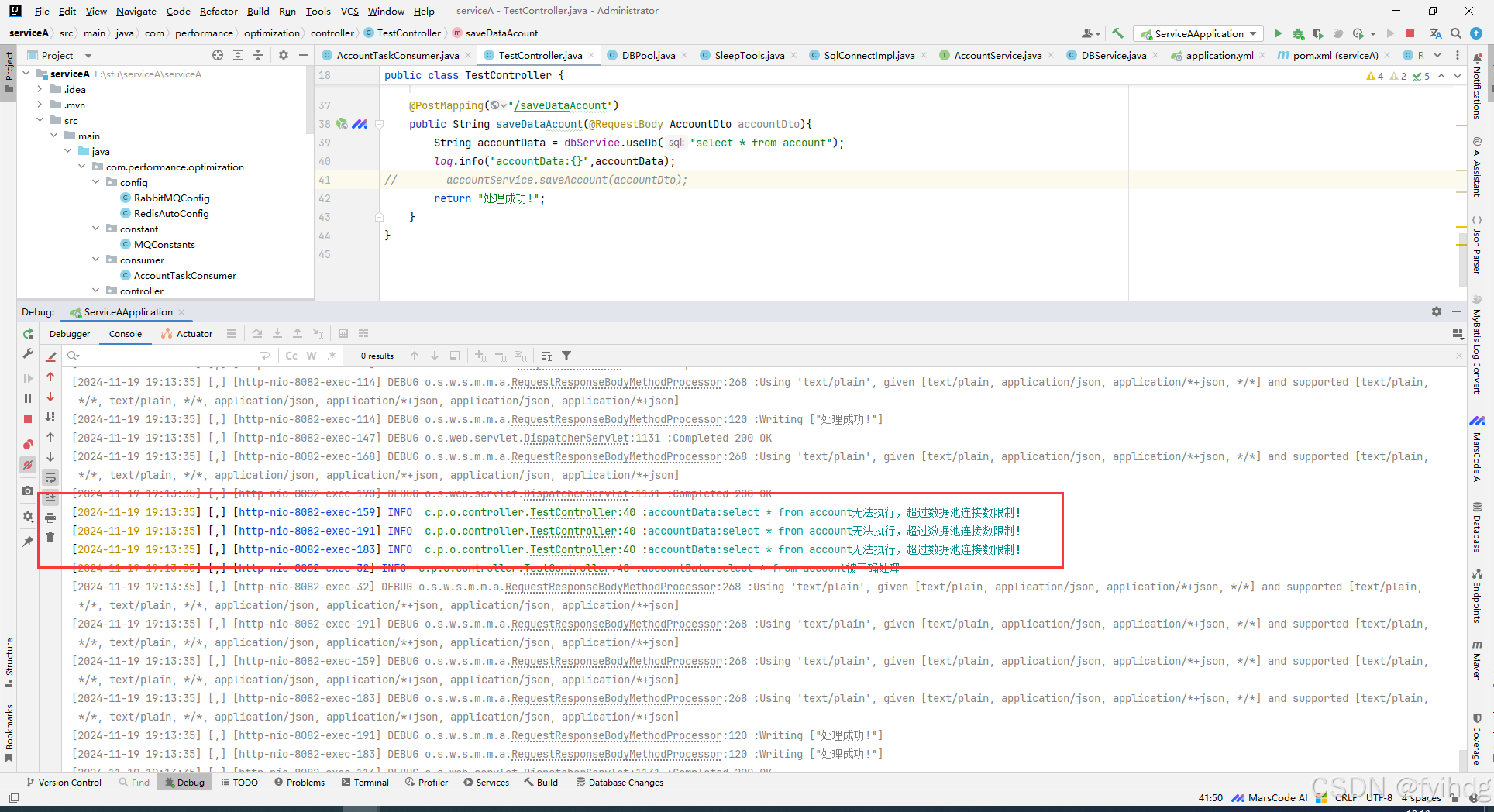
4.2 改造后的接口测试
把上面调用的地址换成改造后的接口,接口名称,入参不变,路径变了:
java
private final String exampleUrl = "http://localhost:8081/serviceapi/saveDataAcount";接口并发能力显著提升,没有报数据库连接不够的问题
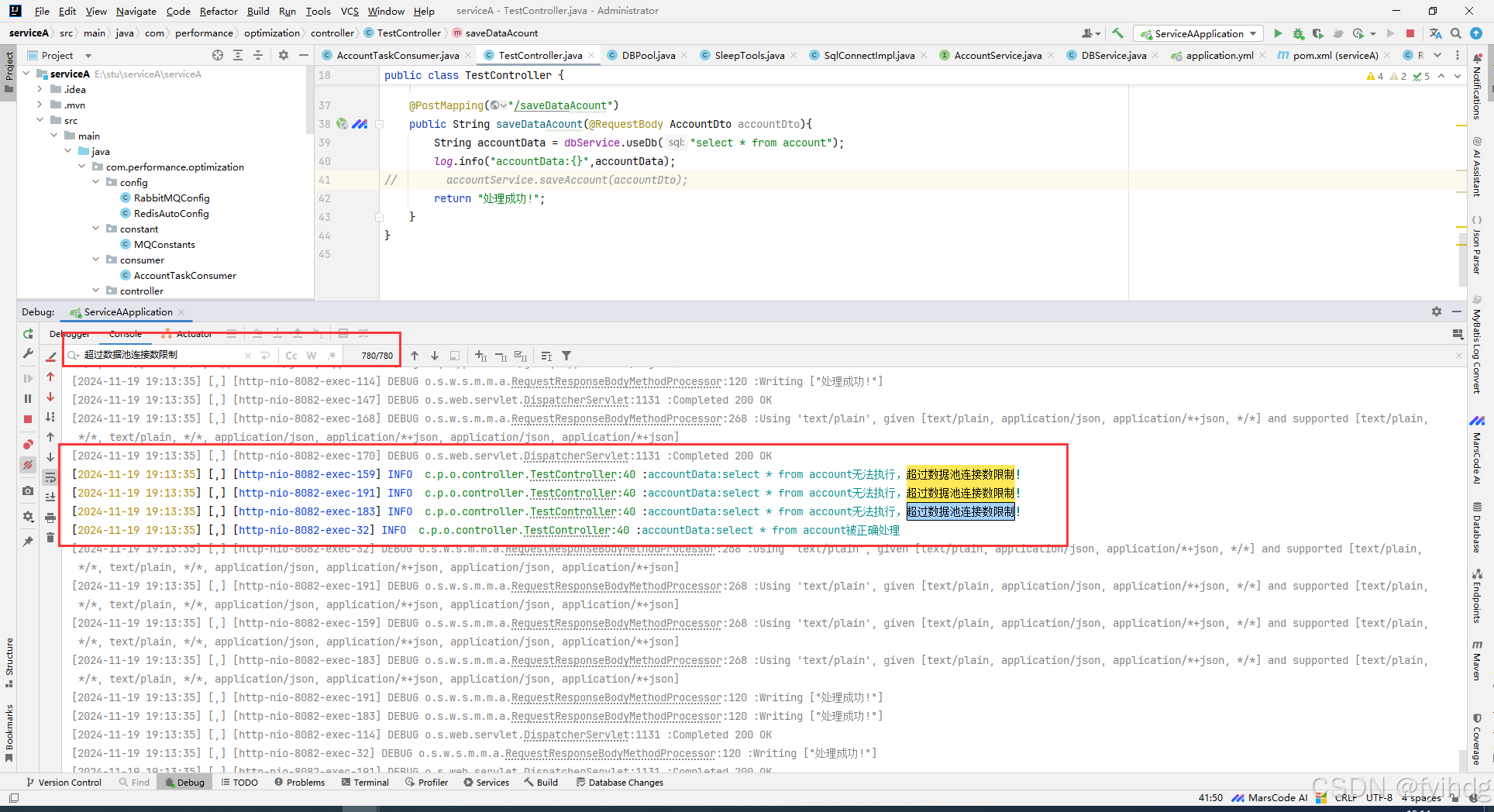
因为我们把请求转到rabbitmq中作削峰填谷,相当于一个蓄水池,我们慢慢消费,就不会有问题
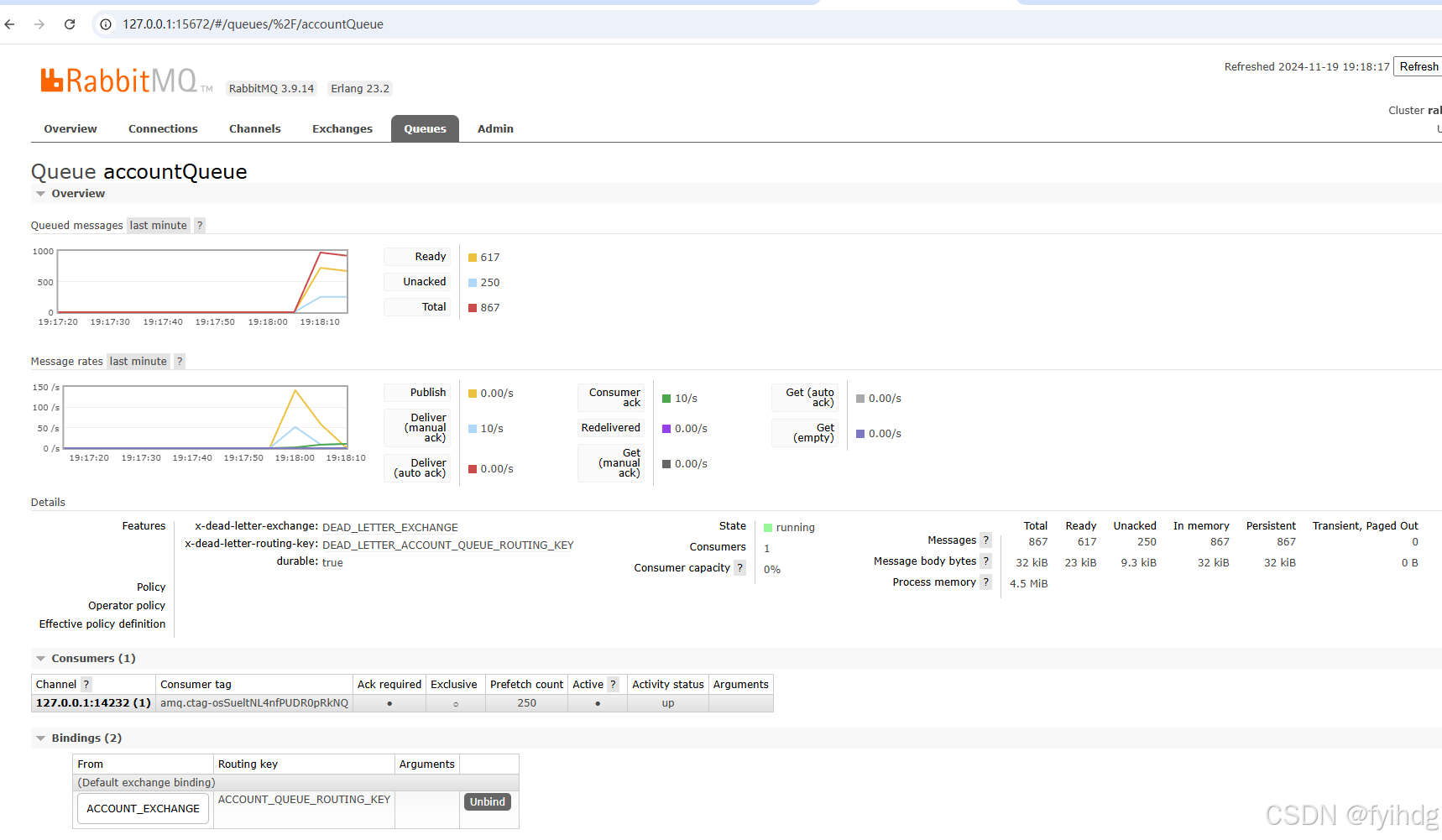
同时kafka也收到消息,模拟调用方收到处理后的消息:
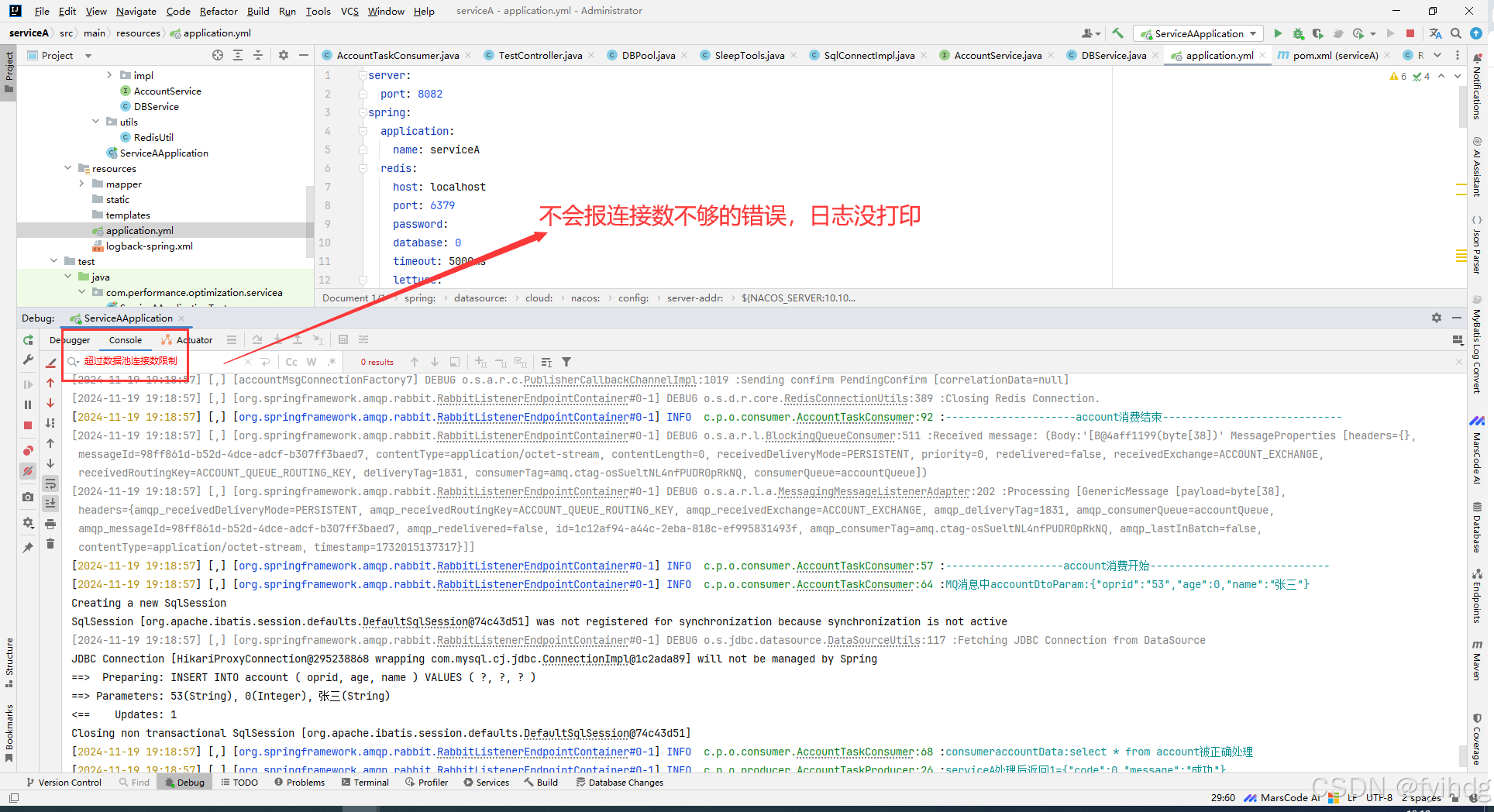

5.搭建test-gateway网关服务
因为接口是对外服务的,为了安全,我们需要对接口进行限流保护,万一流量太大,把我们系统压跨了,会导致我们系统不可用,所以要进行限流,限流大部分场景是在网关做的,我搭了一个spring cloud gateway网关服务来进行限流。
5.1 限流配置
java
package com.test.gateway.testgateway.limiters;
import com.test.gateway.testgateway.properties.RequestLimiterUrlProperties;
import org.springframework.cloud.gateway.filter.ratelimit.KeyResolver;
import org.springframework.context.annotation.Bean;
import org.springframework.context.annotation.Configuration;
import org.springframework.context.annotation.Primary;
import reactor.core.publisher.Mono;
import java.util.List;
/***
* @Description 限流配置
* @Author degui.huang
* @Version 1.0
*/
@Configuration
public class LimiterConfig {
@Bean
@Primary
public KeyResolver customPathKeyResolver(RequestLimiterUrlProperties requestLimiterUrlProperties) {
return exchange -> {
String path = exchange.getRequest().getURI().getPath();
List<String> limitedPaths = requestLimiterUrlProperties.getList();
if (requestLimiterUrlProperties.getEnabled() && limitedPaths.contains(path)) {
return Mono.just("rate_limit_key");
}
return Mono.just(path);
};
}
}5.2 实现请求的限流功能
java
package com.test.gateway.testgateway.limiters;
import com.test.gateway.testgateway.properties.RequestLimiterUrlProperties;
import org.springframework.cloud.gateway.filter.GatewayFilter;
import org.springframework.cloud.gateway.filter.factory.RequestRateLimiterGatewayFilterFactory;
import org.springframework.cloud.gateway.filter.ratelimit.KeyResolver;
import org.springframework.cloud.gateway.filter.ratelimit.RateLimiter;
import org.springframework.cloud.gateway.route.Route;
import org.springframework.cloud.gateway.support.ServerWebExchangeUtils;
import org.springframework.core.io.buffer.DataBuffer;
import org.springframework.http.HttpStatus;
import org.springframework.http.server.reactive.ServerHttpResponse;
import org.springframework.stereotype.Component;
import reactor.core.publisher.Mono;
import java.nio.charset.StandardCharsets;
import java.util.Map;
/***
* @Description 限流实现
* @Author degui.huang
* @Version 1.0
*/
@Component
public class LimitersGatewayFilterFactory extends RequestRateLimiterGatewayFilterFactory {
private final RateLimiter defaultRateLimiter;
private final KeyResolver defaultKeyResolver;
private final RequestLimiterUrlProperties requestLimiterUrlProperties;
public LimitersGatewayFilterFactory(RateLimiter defaultRateLimiter, KeyResolver defaultKeyResolver, RequestLimiterUrlProperties requestLimiterUrlProperties) {
super(defaultRateLimiter, defaultKeyResolver);
this.defaultRateLimiter = defaultRateLimiter;
this.defaultKeyResolver = defaultKeyResolver;
this.requestLimiterUrlProperties = requestLimiterUrlProperties;
}
@Override
public GatewayFilter apply(Config config) {
KeyResolver resolver = getOrDefault(config.getKeyResolver(), defaultKeyResolver);
RateLimiter<Object> limiter = getOrDefault(config.getRateLimiter(), defaultRateLimiter);
return (exchange, chain) -> resolver.resolve(exchange).flatMap(key -> {
String routeId = config.getRouteId();
if (routeId == null) {
Route route = exchange.getAttribute(ServerWebExchangeUtils.GATEWAY_ROUTE_ATTR);
routeId = route.getId();
}
String path = exchange.getRequest().getURI().getPath();
return limiter.isAllowed(routeId, key).flatMap(response -> {
for (Map.Entry<String, String> header : response.getHeaders().entrySet()) {
exchange.getResponse().getHeaders().add(header.getKey(), header.getValue());
}
if (response.isAllowed() || !requestLimiterUrlProperties.getEnabled()) {
return chain.filter(exchange);
}
if (!requestLimiterUrlProperties.getList().contains(path)) {
return chain.filter(exchange);
}
ServerHttpResponse httpResponse = exchange.getResponse();
//修改code为500
httpResponse.setStatusCode(HttpStatus.TOO_MANY_REQUESTS);
if (!httpResponse.getHeaders().containsKey("Content-Type")) {
httpResponse.getHeaders().add("Content-Type", "application/json");
}
//此处无法触发全局异常处理,手动返回
DataBuffer buffer = httpResponse.bufferFactory().wrap(("{\n"
+ " \"code\": \"429\","
+ " \"message\": \"请求过于频繁,请稍后再试\","
+ " \"success\": false"
+ "}").getBytes(StandardCharsets.UTF_8));
return httpResponse.writeWith(Mono.just(buffer));
});
});
}
private <T> T getOrDefault(T configValue, T defaultValue) {
return (configValue != null) ? configValue : defaultValue;
}
}5.3 定义限流策略中的键
java
package com.test.gateway.testgateway.limiters;
import org.springframework.cloud.gateway.filter.ratelimit.KeyResolver;
import org.springframework.web.server.ServerWebExchange;
import reactor.core.publisher.Mono;
/***
* 定义限流策略中的键
* @Author degui.huang
* @Version 1.0
*/
public class LimitersKeyResolver implements KeyResolver {
@Override
public Mono<String> resolve(ServerWebExchange exchange) {
return Mono.just(exchange.getRequest().getPath().toString());
}
}5.4 限流配置
java
package com.test.gateway.testgateway.properties;
import org.springframework.boot.context.properties.ConfigurationProperties;
import org.springframework.stereotype.Component;
import java.util.ArrayList;
import java.util.List;
/***
* @Description 限流配置
* @Author degui.huang
* @Version 1.0
*/
@Component
@ConfigurationProperties(prefix = "limiterurl")
public class RequestLimiterUrlProperties {
public List<String> list = new ArrayList<>();
public boolean enabled;
public List<String> getList() {
return list;
}
public void setList(List<String> list) {
this.list = list;
}
public boolean getEnabled() {
return enabled;
}
public void setEnabled(boolean enabled) {
this.enabled = enabled;
}
}5.5 application.yml和pom.xml
需要注意的是- Path和 - RewritePath,这两个地方开头,一定要全部小写开头,否则没有效果。
java
server:
port: 8088
spring:
application:
name: test-gateway
redis:
host: localhost
port: 6379
password:
database: 0
timeout: 5000ms
lettuce:
pool:
max-active: 8
max-wait: 1000ms
max-idle: 8
min-idle: 0
cloud:
nacos:
config:
server-addr: ${NACOS_SERVER:127.0.0.1:8848}
#服务发现
discovery:
server-addr: ${NACOS_SERVER:127.0.0.1:8848}
username: nacos
password: nacos
gateway:
routes:
#exampleServiceAPI 对外提供接口服务
- id: exampleServiceAPIId
uri: lb://exampleServiceAPI
#千万要注意:这个路径开头一定要全小写!!exampleapi这个必须小写!否则没有效果!
predicates:
- Path=/exampleapi/** #路由匹配
filters:
- name: Limiters
args:
key-resolver: "#{@customPathKeyResolver}"
redis-rate-limiter.replenishRate: 100 # 每秒100个请求
redis-rate-limiter.burstCapacity: 100 # 最大并发容量100
#千万要注意:这个路径开头一定要全小写!!exampleapi这个必须小写!否则没有效果!
- RewritePath=/exampleapi/(?<segment>.*), /${segment} #路由重写
#限流url
#把想要限流的接口放到下面列表中,就达以限流的目的
limiterurl:
#enabled true 开启限流,false 关闭限流,这个配置可以写在nacosa 配置中,可以理解成限流的开关
enabled: true
list:
- /exampleapi/serviceapi/saveDataAcount
XML
<?xml version="1.0" encoding="UTF-8"?>
<project xmlns="http://maven.apache.org/POM/4.0.0" xmlns:xsi="http://www.w3.org/2001/XMLSchema-instance"
xsi:schemaLocation="http://maven.apache.org/POM/4.0.0 https://maven.apache.org/xsd/maven-4.0.0.xsd">
<modelVersion>4.0.0</modelVersion>
<parent>
<groupId>org.springframework.boot</groupId>
<artifactId>spring-boot-starter-parent</artifactId>
<version>2.7.14</version>
<relativePath/>
</parent>
<groupId>com.test.gateway</groupId>
<artifactId>test-gateway</artifactId>
<version>0.0.1-SNAPSHOT</version>
<name>test-gateway</name>
<description>test-gateway</description>
<properties>
<java.version>1.8</java.version>
<spring.cloud.version>2021.0.5</spring.cloud.version>
<spring.cloud.alibaba.version>2021.0.5.0</spring.cloud.alibaba.version>
<spring.boot.version>2.7.14</spring.boot.version>
</properties>
<dependencies>
<dependency>
<groupId>org.projectlombok</groupId>
<artifactId>lombok</artifactId>
<optional>true</optional>
</dependency>
<dependency>
<groupId>org.springframework.boot</groupId>
<artifactId>spring-boot-starter-test</artifactId>
<scope>test</scope>
</dependency>
<!-- 网关依赖-->
<dependency>
<groupId>org.springframework.cloud</groupId>
<artifactId>spring-cloud-starter-gateway</artifactId>
</dependency>
<!--fastjson -->
<dependency>
<groupId>com.alibaba</groupId>
<artifactId>fastjson</artifactId>
<version>1.2.83</version>
</dependency>
<!-- redis相关-->
<dependency>
<groupId>org.springframework.boot</groupId>
<artifactId>spring-boot-starter-data-redis-reactive</artifactId>
</dependency>
<!-- hutool-->
<dependency>
<groupId>cn.hutool</groupId>
<artifactId>hutool-all</artifactId>
<version>5.8.1</version>
</dependency>
<dependency>
<groupId>org.springframework.cloud</groupId>
<artifactId>spring-cloud-starter-bootstrap</artifactId>
</dependency>
<!-- nacos注册中心依赖 -->
<dependency>
<groupId>com.alibaba.cloud</groupId>
<artifactId>spring-cloud-starter-alibaba-nacos-discovery</artifactId>
</dependency>
<!-- nacos配置中心依赖 -->
<dependency>
<groupId>com.alibaba.cloud</groupId>
<artifactId>spring-cloud-starter-alibaba-nacos-config</artifactId>
</dependency>
<!-- 实现负载均衡-->
<dependency>
<groupId>org.springframework.cloud</groupId>
<artifactId>spring-cloud-loadbalancer</artifactId>
</dependency>
<!-- 日志 -->
<dependency>
<groupId>ch.qos.logback</groupId>
<artifactId>logback-classic</artifactId>
</dependency>
<!--日志以json格式输出所需-->
<dependency>
<groupId>net.logstash.logback</groupId>
<artifactId>logstash-logback-encoder</artifactId>
<version>6.6</version>
</dependency>
</dependencies>
<dependencyManagement>
<dependencies>
<dependency>
<groupId>org.springframework.cloud</groupId>
<artifactId>spring-cloud-dependencies</artifactId>
<version>${spring.cloud.version}</version>
<type>pom</type>
<scope>import</scope>
</dependency>
<dependency>
<groupId>com.alibaba.cloud</groupId>
<artifactId>spring-cloud-alibaba-dependencies</artifactId>
<version>${spring.cloud.alibaba.version}</version>
<type>pom</type>
<scope>import</scope>
</dependency>
<dependency>
<groupId>org.springframework.boot</groupId>
<artifactId>spring-boot-dependencies</artifactId>
<version>${spring.boot.version}</version>
<type>pom</type>
<scope>import</scope>
</dependency>
</dependencies>
</dependencyManagement>
<build>
<plugins>
<plugin>
<groupId>org.springframework.boot</groupId>
<artifactId>spring-boot-maven-plugin</artifactId>
<configuration>
<excludes>
<exclude>
<groupId>org.projectlombok</groupId>
<artifactId>lombok</artifactId>
</exclude>
</excludes>
</configuration>
</plugin>
</plugins>
</build>
</project>6. JMeter 限流测试
我已经搭建好三个服务了,都成功注册到 nacos中,接下来进行限流测试。

6.1 JMeter 配置
我在网关配置是每秒100个请求,最大并发容量100,我线程数写500,1秒钟内跑完

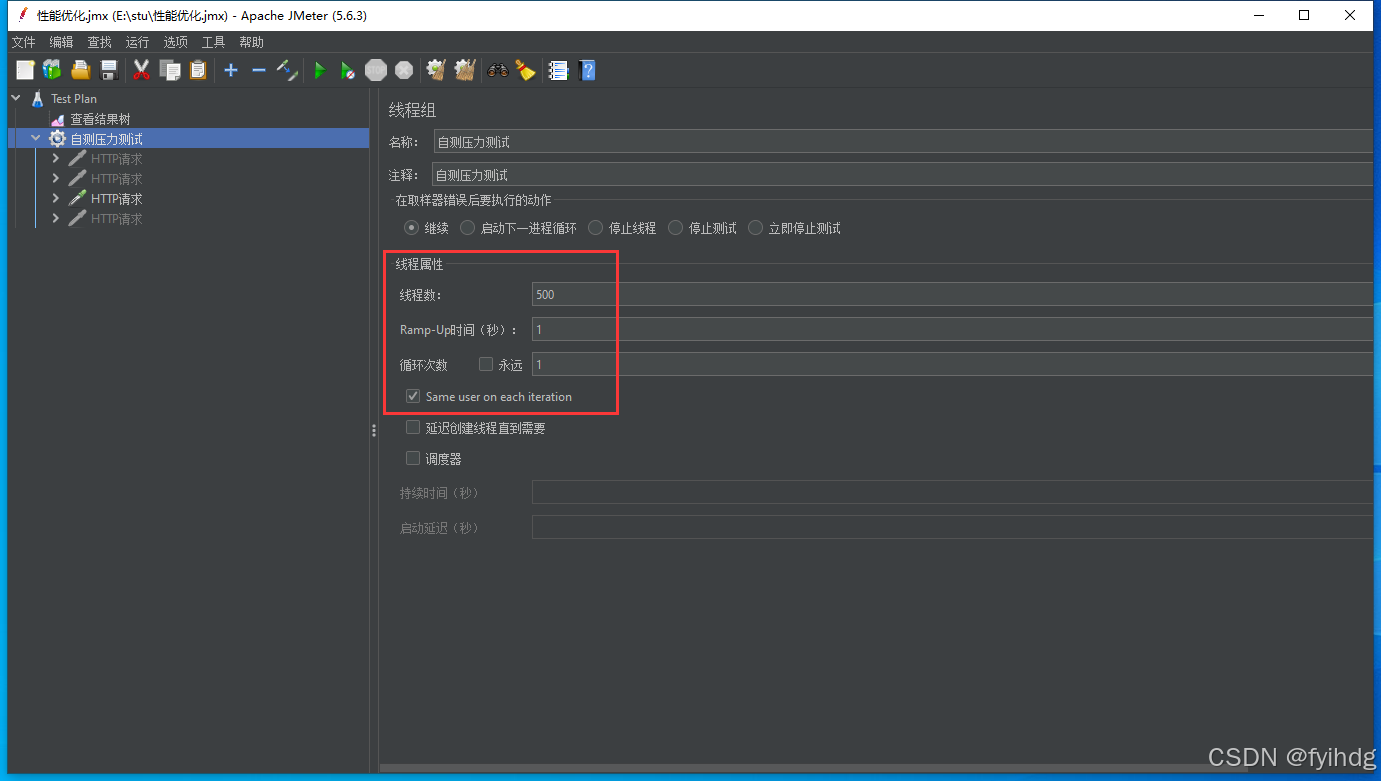
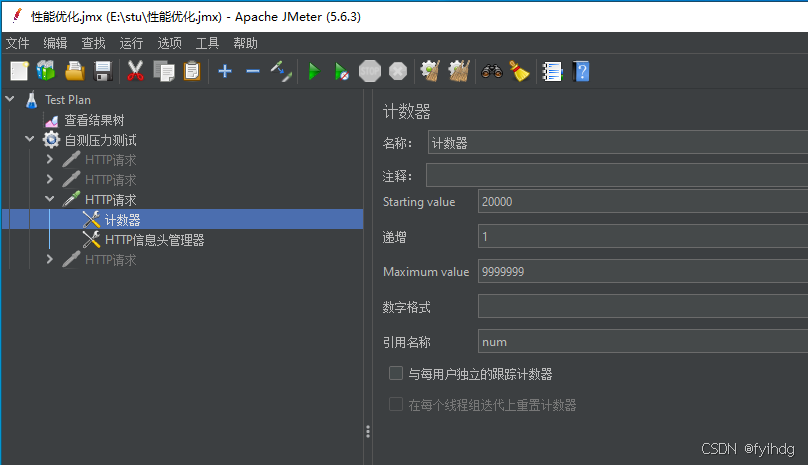

请求路径 :
java
http://localhost:8088/exampleapi/serviceapi/saveDataAcount消息体
java
{
"oprid": ${num},
"age": 76,
"name": "网关测试"
}6.2 压测结果
我请求的服务是exampleServiceAPI中的saveDataAcount接口,会打印"accountDto入参"这个日志,我们只要查找这个关键字的次数,就知道有多少个请求成功打到我们exampleServiceAPI这个服务了,我们是500个线程,理论上就是最多有200个请求到达。
1秒内,只会有200个请求到达

模拟业务方也收到kakfa消息了:

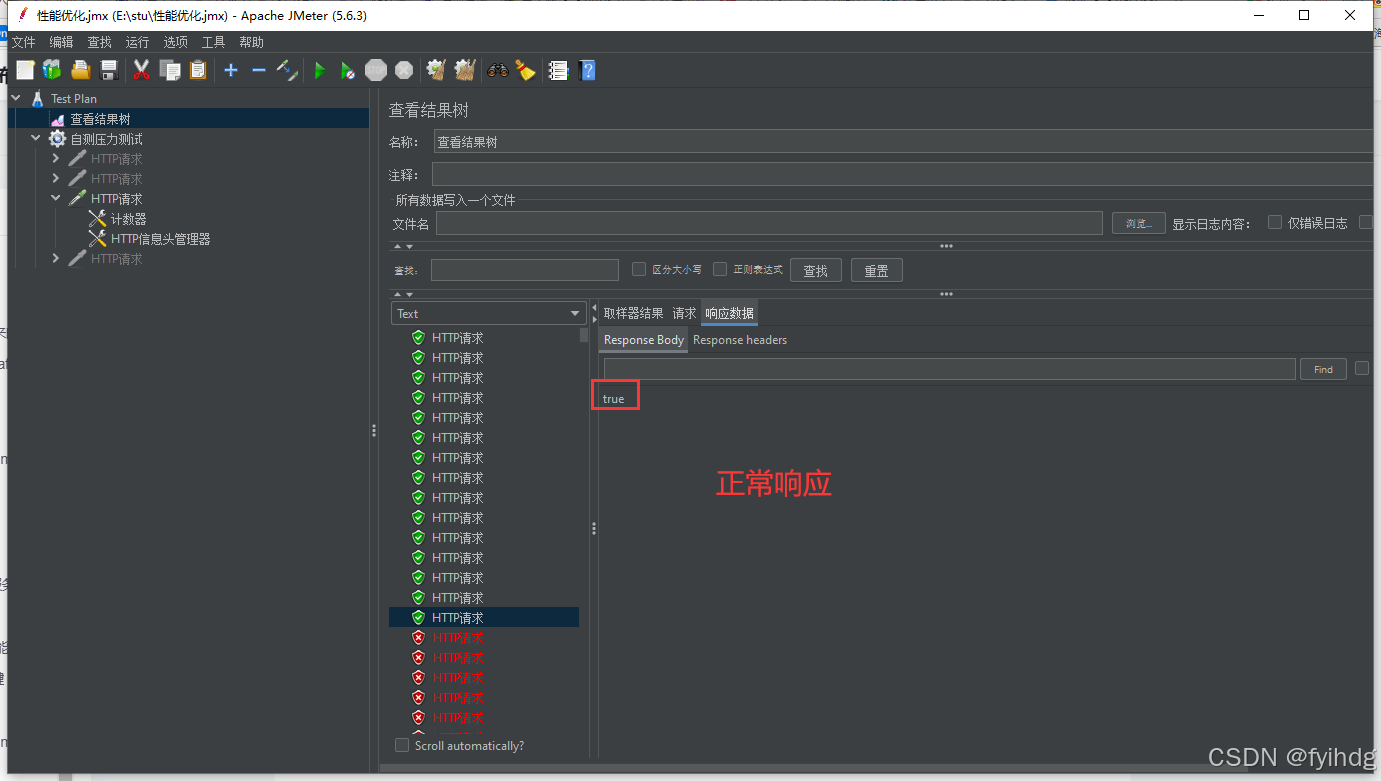
超过就会被拒绝请求:
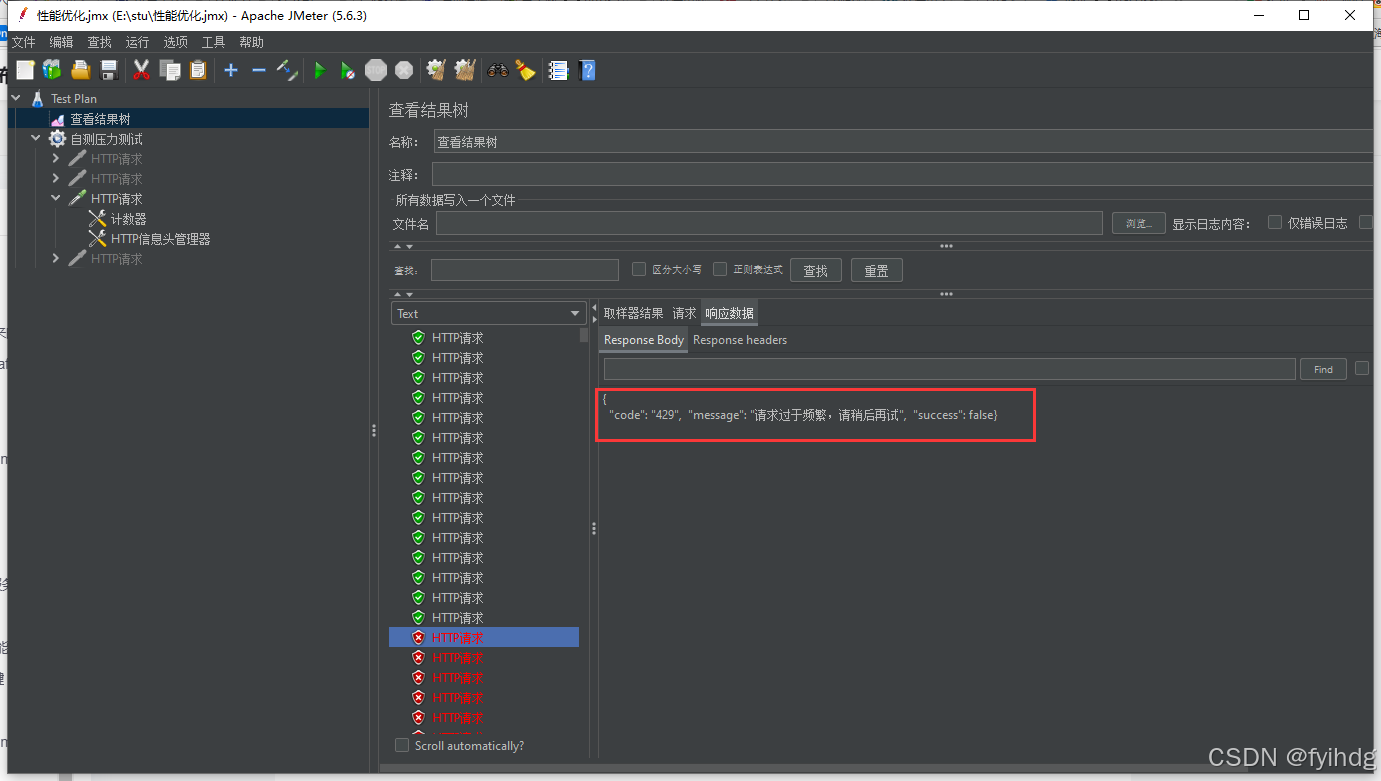
我把本次代码和相关软件全部打包上传到这了,可以免积下载:
https://download.csdn.net/download/fyihdg/90017490![]() https://download.csdn.net/download/fyihdg/90017490windows下安装rabbitMQ可以看篇文章:
https://download.csdn.net/download/fyihdg/90017490windows下安装rabbitMQ可以看篇文章:
windows下安装kafka 安装可以看这篇文章:
如果觉得我的文章或者代码对您有帮助,可以请我喝杯咖啡
您的支持将鼓励我继续创作!谢谢!

